From the Collection of Mike and Peter Newmarch, Greytown, Kwa Zulu, South Africa
1) Letter from William John Sawdon Newmarch to his father January 11th 1879
Fort Pearson1
January 11th 1879
My Dear Father,
We got down from Grott? spruitii2 and we will cross over into the Zulu country in a day or two.
The Barrow horseiii3 and the Victoria Mounted Rifles cross tomorrow morning.
This morning a lot of niggers gathered together opposite the fort and as it was a nice chance for the Blue Jackets to try their Armstrong guns4 they fired two shells at them.
The first shell dropped a little beyond them and exploded, the second dropped in the midst of them but did not explode.
But for all that it sent them running off like mad.
I am in very good health at present and have quite recovered from the fever I had in Durban.
Please address any letters to Fort Pearson Lower Tugela
With Best love to Mama and the rest and accept the same yourself from your affectionate son
W J S Newmarch
2) Letter from W J S Newmarch to his mother February 24th 1879
Thrings Post (Natal)5
February 2nd 1879
Dear Mother
I suppose you will be surprised to see that we are in Natal again.6 As soon as Colonel Pearson heard the news of Col. Glynn’s men being killed 7 He sent all the Volunteers and Mounted Inf[antry] back to Natal; and remained at Eshowe with with all the infantry comprising the 3rd Buffs8, the 99th Regiment9 the Naval Brigade10 and a company of Engineers.11
At Eshowe, Col Pearson can defy the whole of the Zulu nation, as he has had large earth works thrown up and deep ditches dug all round, and further he has set dynamite all around the fort connected by an electric battery.
The Naval Brigade have 4 large guns and 2 Rocket tubes and a couple of Gatlings12, with them, which are now on the walls of Fort Eshowe. At Eshowe they have provisions for two months.13
In my last letter of either the 23rd or 24th of Jan I told you of our having a battle with the Zulus14 in which 8 white men were killed being officers of the native contingent and soldiers, and that 13 were wounded out of which 3 have died since. Over three hundred (300) of the Zulus were killed.
Please address any letters to Thrings Post for the present (perhaps you will have to address them to Kranz Kop before long but not until I let you know)15
Give my best love to papa and the rest.
Accept the same yourself from your affect[ionate] son.
W J S Newmarch16
APPENDIX: W J S Newmarch’s First Engagement
The letter above gives W J S Newmarch’s account of the Battle of Nyezane, the first major battle of the Zulu War and William’s baptism of fire. He probably had however, already been involved in one minor skirmish ten days before:
From The Washing of the Spears
[After crossing the Tugela on Jan 12th}….“Cavalry patrols penetrated ten miles into the countryside without encountering any opposition. Major Barrow stumbled on a dozen warriors who threw down their shields and assegais and tried to run as he pounced on them with the Natal Hussars. He captured five of them; one complained bitterly that 200 mounted men were not fair odds for a dozen men afoot, and he promised them better sport further along.”
3) Letter to William John Sawdon Newmarch from a fellow officer June 16th 1879
Dear Newmarch17
If Geo[rge] Robinson18 has not turned up to deliver some horses to these Natives would you please retain the Natives until he does. Drop us a line by these boys as to how matters are getting on there 19– we are swamped out with Rain and such like – little chance of making a move forward as long as we have such a fool at the head of matters20 – Fancy sending off a mounted force at dead of night to steal two bottles of water from the Umlalazi River for fear we may be fired at as it is known there are about 1000 Natives there! The most natural thing would have been to send the force to drive them out and then take the water – these Natives are only 7 miles from our camp and have been all along. They occasionally shoot a stray Native of ours but no notice is taken of it; and they are reaping their crops putting them in pits not 4 miles from our camp. Have you been having all this rain up there it is surely unusual.
In haste,
[Catousel ?? – Name illegible21]
F[or]t Chelmsford 16-6-79
It will be difficult really to pin the facts behind this letter down until we have more information about W J S Newmarch’s operations during the Zulu War. There may emerge new letters out of the Newmarch vault. We know that at least one has yet to be found (the letter he wrote his mother on 23rd/24th January 1879 describing in detail the Battle of Inyezane).
We know from these letters a lot already, that W J S Newmarch joined up a youth of 18 and six months later was a hardened soldier. He continued this profession, fought throughout the Boer War, amongst other things participating in the Siege of Ladysmith. In 1906/7 he was called to war again when Prince Dinizulu, heir to the Zulu throne, was centre of an insurrection in Natal, now known as Bambatha’s Rebellion, during one point of which an older W J S Newmarch, according to Peter, was in overall command.
His efforts in the Zulu War were anyway appreciated. Peter Newmarch has established that his great grandfather received a medal for his services in the Natal Hussars.
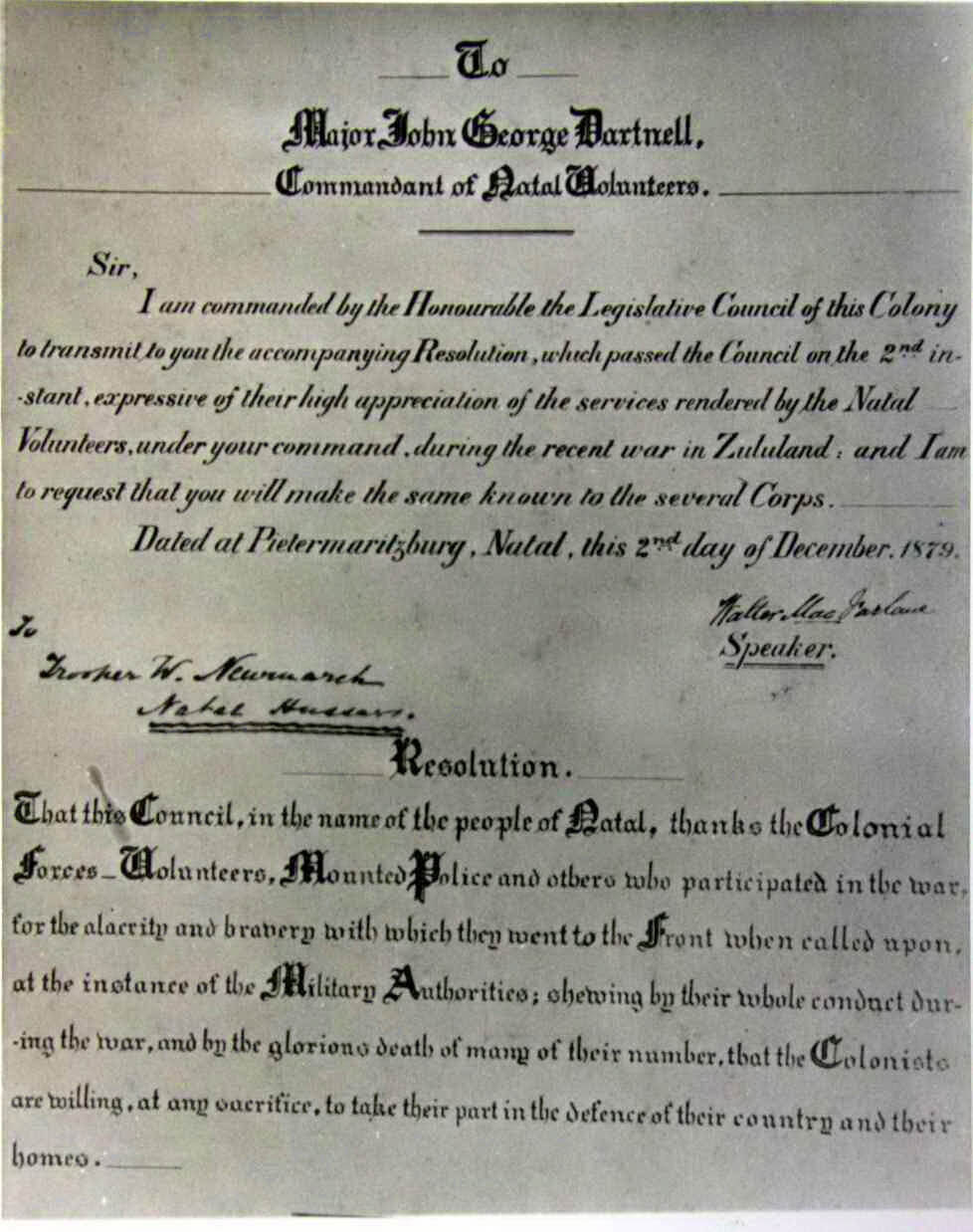
Appendix: Mary Margaret Newmarch’s Diary 1879
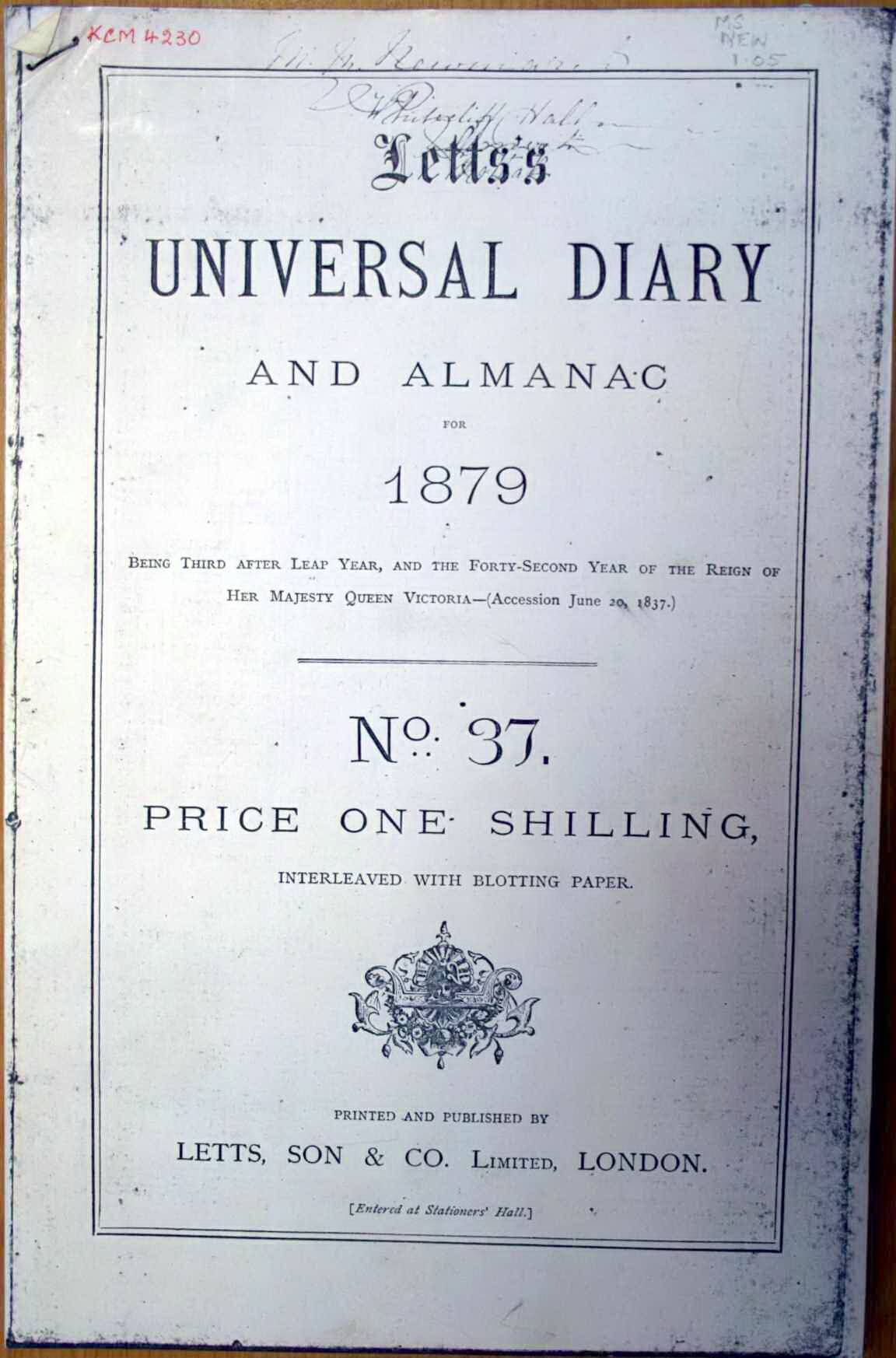
Mary Margaret Newmarch’s Diary 1879
January 22 Wednesday
The Zulus have killed a great many of our forces at Rorkes Drift. About half of the Carbineers have been killed. Jackson’s brother one of them. Col. Pearson was attacked at the same time, at Inyansana [misspelling of Inyezane?] but beat the Zulus [illegible word].
January 23 Thursday
Mama went down the thorns & heard from the kafir women of our defeat but would not believe it was true.
January 24 Friday
Cutting wood to take into Greytown, ploughing in the far land. Hot day.
January 25 Saturday
Papa went into Greytown, and came home much earlier than usual. He had heard of our defeat, and that the Zulus were over the border [ illegible] force. He came at once to tell us to go into Greytown. Packing till late.
January 26 Sunday
Finished packing and got into town about 2 o’clock. Staying at Uncle Edward’s. No more news from the front.
January 27 Monday
Getting things put straight Mrs Lodvick came down to see us. Uncle William came from P. M. Burg, riding dispatches. Eddie and Johnny went down to P.M. Burg . Went in the evening to see Mrs Meickle]. She went with us to see Mrs Stewart.
January 28 Tuesday
Went to Mrs Stewarts for my first music lesson with her. Very hot day. Mrs Plant came to see us. Eddie wrote to say Mr Ellis would not take the responsibility of the boys upon him.
January 29 Wednesday
Old Mr White came to see us: he has been staying in the Zulu Country for some time past. Mrs Leverhals came down too. Very hot day. Had a bath which was refreshing. No letter from Willie. Mama in a great way.
January 30 Thursday
Very hot. Misses Leuchars & Miss Lodwicks been down here. Mr Leuchars been here too.
January 31 Friday
Had a letter from E. Plummer, people went into laager when they heard of the Rorkes Drift affair.
February 1 Saturday
Mama got a letter from Willie: and is now alright. Wet day, and cannot get the house cleaned.
February 2nd Sunday
Dull day. Went to church. In the afternoon went down with Mrs Meikle to see the laager.
February 3rd Monday
About 2 o’clock this morning Mr Luchez [sp?] woke us up & told us to go into laager & that the Zulus were over the border, we were down in about ten minutes: as all seemed quiet, we came back about 6 o’clock. No news through the day; went down in the evening to the laager about 8 o’clock. News came that there was not a Zulu to be seen.
February 4th Tuesday
Passed a very comfortable night up here. Those who stayed in the laager did not. Two alarms to be given when the Zulus are coming, first the band, 2nd the bell is to ring. This afternoon the bell tolled, there was rushing in every direction. It was a false alarm. They had been hanging the bell. We had a good laugh at the hurry – [2 words illegible ] . Sent the children to sleep in the laager.
February 5th Wednesday
Very windy night but no alarms. Had a good night’s rest. Mrs Plant & Uncle been to see how we are in a great Hurry, thinks the Zulus will be here on Friday. The children slept in the laager. We went down with them. Uncle slept there too. Heavy rain about 10 o’clock will make the air much cooler than it has been.
February 6th Thursday
Fine fresh morning. Mrs Plant was going to have [words indistinct] put up in the laager & shared it with us, but she heard all were to be struck tomorrow, so it was not worth while. Very hot in the afternoon. Major Trevelyan called but we were out. Miss Strickland and Florence came by this evening. Thundering & lightning very much, sure to be a storm before morning. Papa out tonight on patrol duty. Uncle Edward could not go down to the laager because of [back ache?]
February 7th Friday
Fresh morning after the rain. We had bad night. Papa did not get [word indistinct] last night. George gone out to the farm. Mrs Brooks came up and stayed most of the day. Very hot about noon. A little rain in the afternoon, which has cooled the air very much. Mrs Plant came about 4 [pm?]. No letter from Willie. Papa sending his men to their posts on the hills.
February 8th Saturday
Next morning. Patrols who were out last night tried to catch some spies but couldn’t. Mama got a letter from Willie: never was such a letter before. Major Trevelyan came up this afternoon. Also Miss C Whitaker and Miss Lodwick. [Two words illegible ] the evening. Did not send the children to sleep in the laager.
February 9th Sunday
Went to church in the morning. Down to the laager with Mrs Plant in the afternoon. Church again in the evening.
February 10th Monday
I got a letter from Uncle William. Went to see Mrs Meikle in the morning. Stayed at home in the afternoon. Mama and Esty both out. Mrs Plant came in the evening. Children slept at home. Tugela quite full.
February 11th Tuesday
Went to get my music lesson at Mrs Stewart’ but she was too unwell to give me it. Went up with Mrs Plant & Miss Lodwick , and stayed for dinner. Mama got a long letter from Willie. Two soldiers came here, who [word illegible] frightened Estey.
February 12th Wednesday
Called on Mrs Meikle who is ill. Also on Mrs Stewart who is feeling better. And Mr Birtwell and Miss Botha. They are going to their Free State soon. Uncle Edward got letter from England. Papa went up to the Police Camp with his men. Mr Handley has promised to give the men whatever they need.
February 13th Thursday
Pleasant morning, rather inclined to be hot. Mr A [Varty?] down to see papa. Gypsy had three pups, one has died. I went up to Mrs Whitaker in the afternoon, had a game of crocey with Miss C Whitaker, Misses [M.L. Leuchars?] & Mr Warmford. [word illegible] and misty in the evening.
February 14th Friday
Dull day. Papa has got rheumatism. Mr & Mrs Meikle came down in the afternoon and stayed for some lunch. Mr Meikle and Mr [Campbell?] came down. I got two Valentines, both from [name illegible]. Wagon came in from the farm.
February 15th Saturdayy
Fine morning, place very dirty. Shooting match between soldiers and civilians. Ethy? Making peach jam. Soldiers won the match. I went out with the children this afternoon. Cool evening.
February 16th Sunday
Fine morning, but streets very muddy. Went to church. Report came in that there had been fighting at Col. Pearson’s but nothing official.
February 17th Monday
Dull morning. Had school. Mama has been down the town. Mr & Mrs Meikle were here this afternoon. The men here were asked to join the night horse patrol, and only 6 did, they call themselves men but they are not: women will have to patrol before long if things go on like this.
February 18th Tuesday
Beautiful morning. Went down to get my music lesson. Mrs Stewart still in bed but thinks she will be able to give me it tomorrow. Fanny and I went to see Mrs Cross. Mama been out most of the afternoon, she got a letter from Willie through Mr [name illegible]. He is all right. The wagon came in from the farm with wood.
February 19th Wednesday
Dull morning. Fine me towards afternoon. Mrs Lodwick helped to get up a picnic. Ma did not want me to go. [Sentence crossed out]. Mr Gordon & Mr Handley came from Thrings. George & I went for a ride in the afternoon.
February 20h Thursday
Music Day Fine morning. Papa is going out to the farm. I went for my music lesson. Mrs Stewart much better today. Mrs Meikle and Ma went out for a ride. Report says that Col Pearson had a repulse and lost a great many men: how many is not yet known. Papa came back about 6 o’clock. Report not true.
February 21st Friday
Fine morning. [Page? – name indistinct] came to see us. Had school underneath the trees. Very hot at noon. Had a bath in the afternoon. Mrs Holding [rest of sentence unclear]. Mrs Plant came down in the evening. Rained a little. Dreadful windy night. I could not sleep for some time.
February 22nd Saturday
All reports about Col. Pearson said to be untrue. Civilians & soldiers had another match. The latter won. Fearfully hot and close. Went to see Mrs Stewart. Fanny & Ethy went out for a ride. Cool, misty evening.
February 23rd Sunday
Went to church . For the afternoon Mama & I went to see Mrs [name illegible] . well, evening did not go to church.
February 24th Monday
Dull morning, finer towards noon. Mr Michel got up a riding partly to go as far as far as Mr Cameron’s farm. Papa. Mama, George and I went. There were about 35 in all. The ride was delightful. Came home about eight o’clock in the evening. Nelson fell with papa, but he did not come off.
February 25th Tuesday
Papa started early this morning for Thring’s Post. Mama got some stuff to make me a habit. Mrs Cross has promised to make it by tomorrow, as there is a picnic arranged for Thursday. Went to see Mrs Stewart. She seemed better but was still in bed. Load of wood came in from the farm. Mrs Plant very busy.
February 26th Ash Wednesday
Clear morning, rather windy. Noon very hot & windy. George went to the farm and brought (illegible) in. Mrs Meicklen is ill. Went to see Mrs Taylor. The wagons were turned out of the laager. Mama had the wagons brought up. A thunder storm coming in. [Illegible] is not well. J Adams did not come to ride the young horse as promised.
February 27th Thursday
Fine morning, Started for the picnic about 12 & went to the waterfalls. Not so many to the picnic as to the riding party. Came home past Landsberg House, dreadful long way. The General came in from Maritzburg by the post cart. Many of the officers were at the picnic when he came.
February 28th Friday
Paid
Dull morning. General gone to Kranz Kop. Went for my music lesson. Mrs Stewart much better. Papa came in from Thring Post . Mr Leuchers here in the afternoon. General came back from Kranz Kop [next?] evening
February 1st March
Windy.Papa, Mama, Uncle & I went for a ride. We met Mr Whitaker looking for his horse. Went round to see how Mrs Meckle’s party went.
February 2nd March
Jackson came in from the farm. Papa and Fanny went for a ride. Very hot in church.
Footnotes
- Fort Pearson, covering the approaches to the Lower Tugela Drift, on the border of Natal and Zululand. It was to be the crossing point into Zululand for the Right Flank Column led by Col Charles Pearson of the Buffs to invade Zululand after the expiry of the British Ultimatum to the Zulu King on 11th January 1879, the date of this letter. William John Sawdon Newmarch, 18 years old, writing to his father, George William Newmarch, a colonist who came to S. Africa in 1849, is enlisted in the Natal Hussars, a volunteer mounted infantry regiment based in Greytown, Natal, his family home.
- Unable to identify this location. Spruit means stream, a common enough name at the end of a town but the first word is difficult to make out. There is a Grootspruit in KwaZulu Natal but way in the north of what was then Zululand so is unlikely to be the town or hamlet or landmark mentioned here.
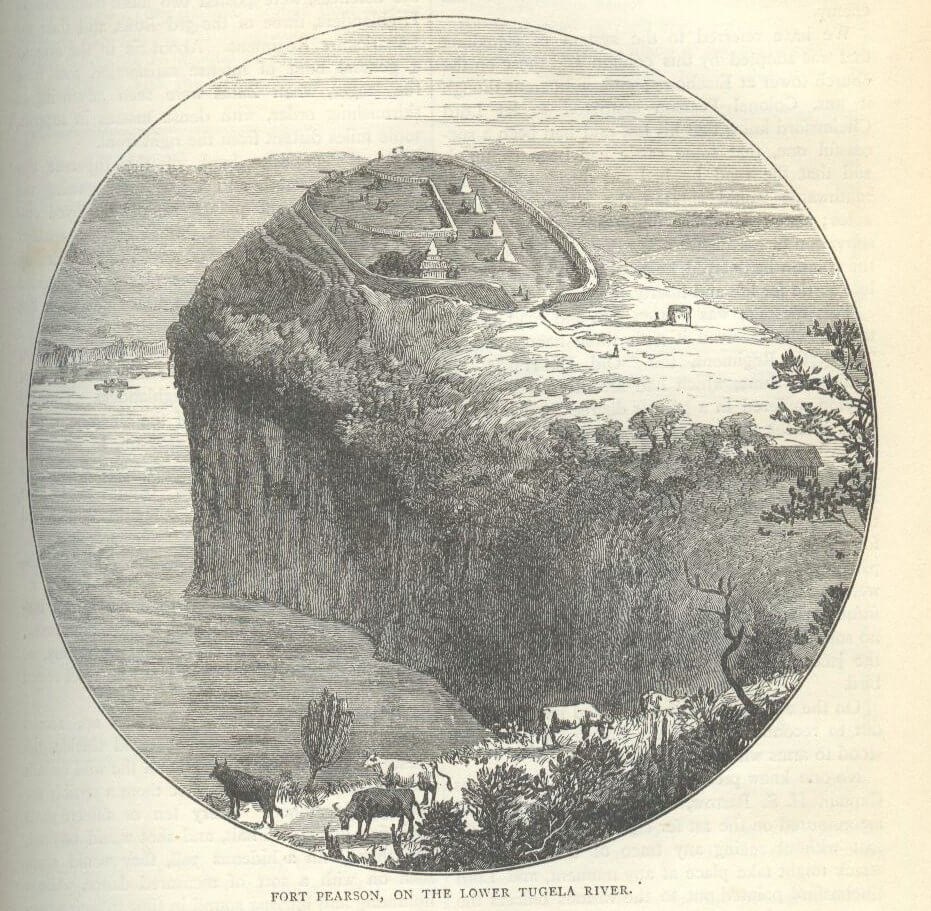
- The Imperial Cavalry under the command of Major Percy Harrow Stanley Barrow, 19th Hussars.
According to Robert R Morris in his ‘The Washing of the Spears’, Barrow was a short, slight man with a shock of red hair and a mobile, expressive face. He was a superb cavalryman and one of the youngest men in the British Army to hold a major’s command. His 312 men included a detachment of Imperial mounted infantry, the Natal Hussars, and the mounted Rifles from Durban, Alexandra, Stanger and Victoria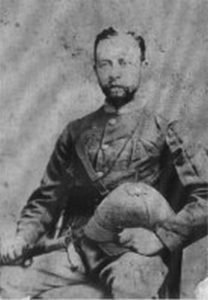
Major Percy Barrow, who was shortly to lead W J S Newmarch and the Natal Hussars into battle
- There were about 200 sailors from the ships Shah and Active accompanying Col Pearson’s column. They came from the two ships HMS Shah and HMS Active, and provided the rockets and Gatlings that accompanied the Left Flank Column under Col Pearson into Zululand. The Armstrong guns being tested against live targets in this letter came from HMS Active. The Armstrong guns were taken into Zululand with the column but were not used at the Battle of Nyezane on 22nd January, being kept in the rear. Perhaps W J S Newmarch’s letter gives an explanation why after the failure to cause any damage that he witnessed!
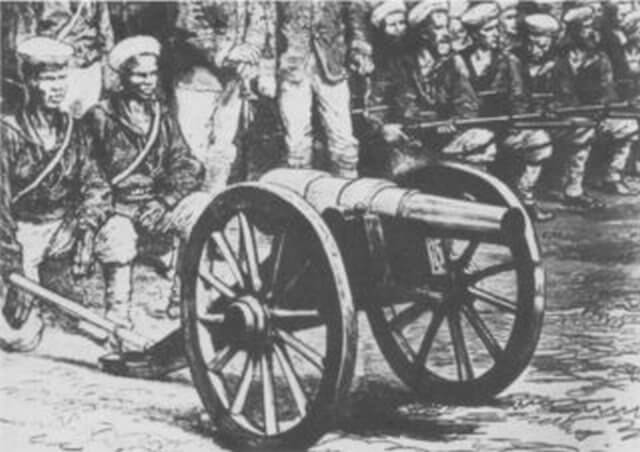
7 Pound Armstrong Gun from HMS Active used in Zulu campaign
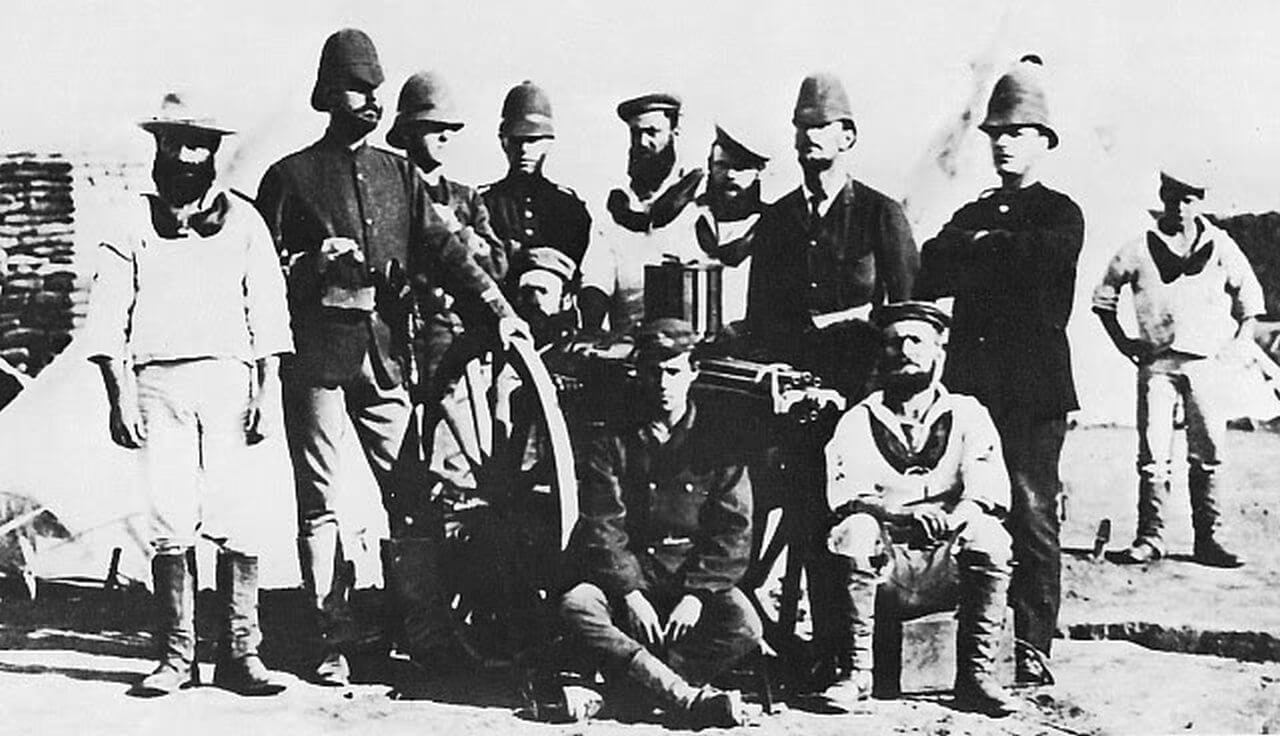
Naval Contingent with Gatling Gun at Fort Pearson, January 1879
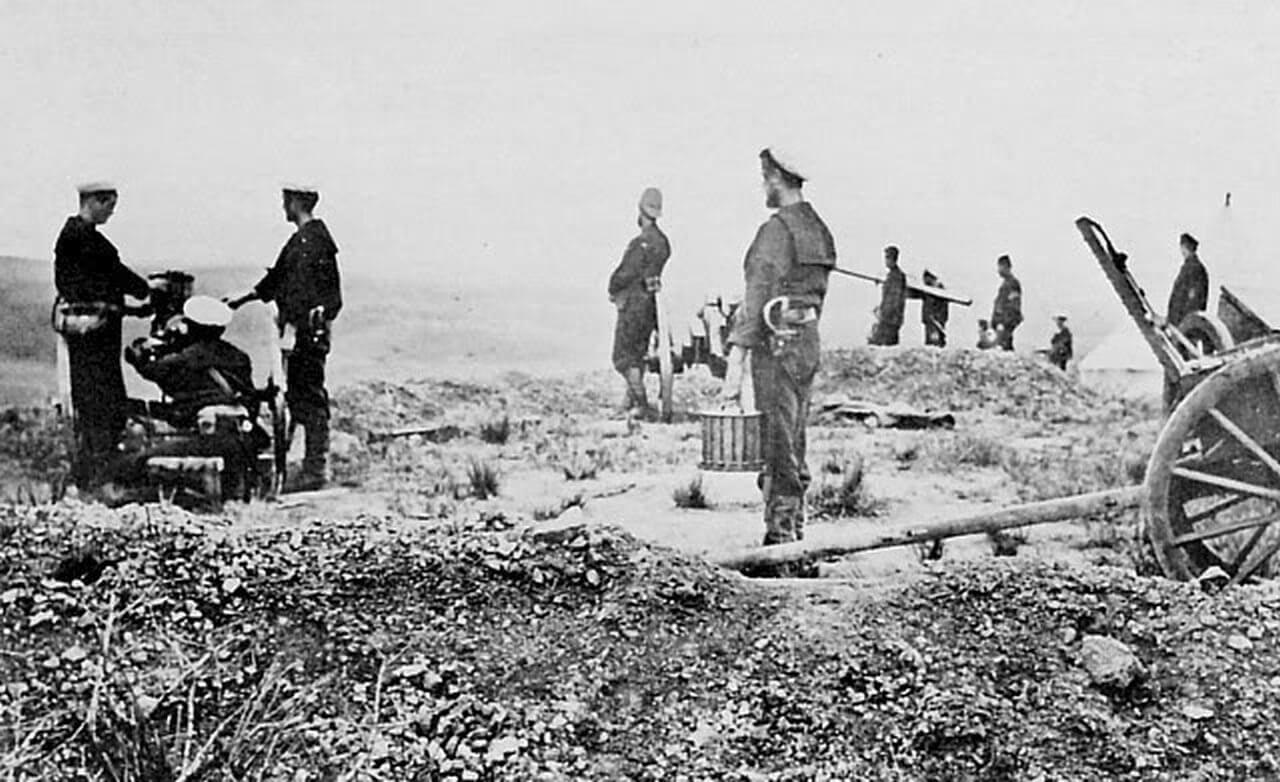
Firing across the Tugela River from Fort Pearson, January 1879
- Thrings Post was a settlement near Stanger on the Natal side of the Tugela River south of the Lower Drift on the coast road to Durban
- Lord Chelmsford, overall British commander, established three columns to invade Zululand on 11th January 1879, the day Britain’s Ultimatum to the Zulu King, Cetshwayo, expired. These were: the Left Flank Column under Col. Evelyn Wood that advanced across the Blood River and eventually engaged the Zulus at Hlobane and Kambula; the Central Column under the command of Col Richard Thomas Glyn of the 24th regiment which advanced from Rorkes Drift towards Isandhlwana; and the Right Flank Column under Colonel Charles Knight Pearson that advanced from Lower Drift towards Eshowe. W J Newmarch is attached to Colonel Pearson’s Right Flank Column, in the ranks of the Natal Huzzars, which, with four other mounted local mounted rifles units, was commanded by Major Percy Harrow Stanley Barrow, 19th Huzzars. (For history of the Natal Huzzars see Appendix 1and 2 below)
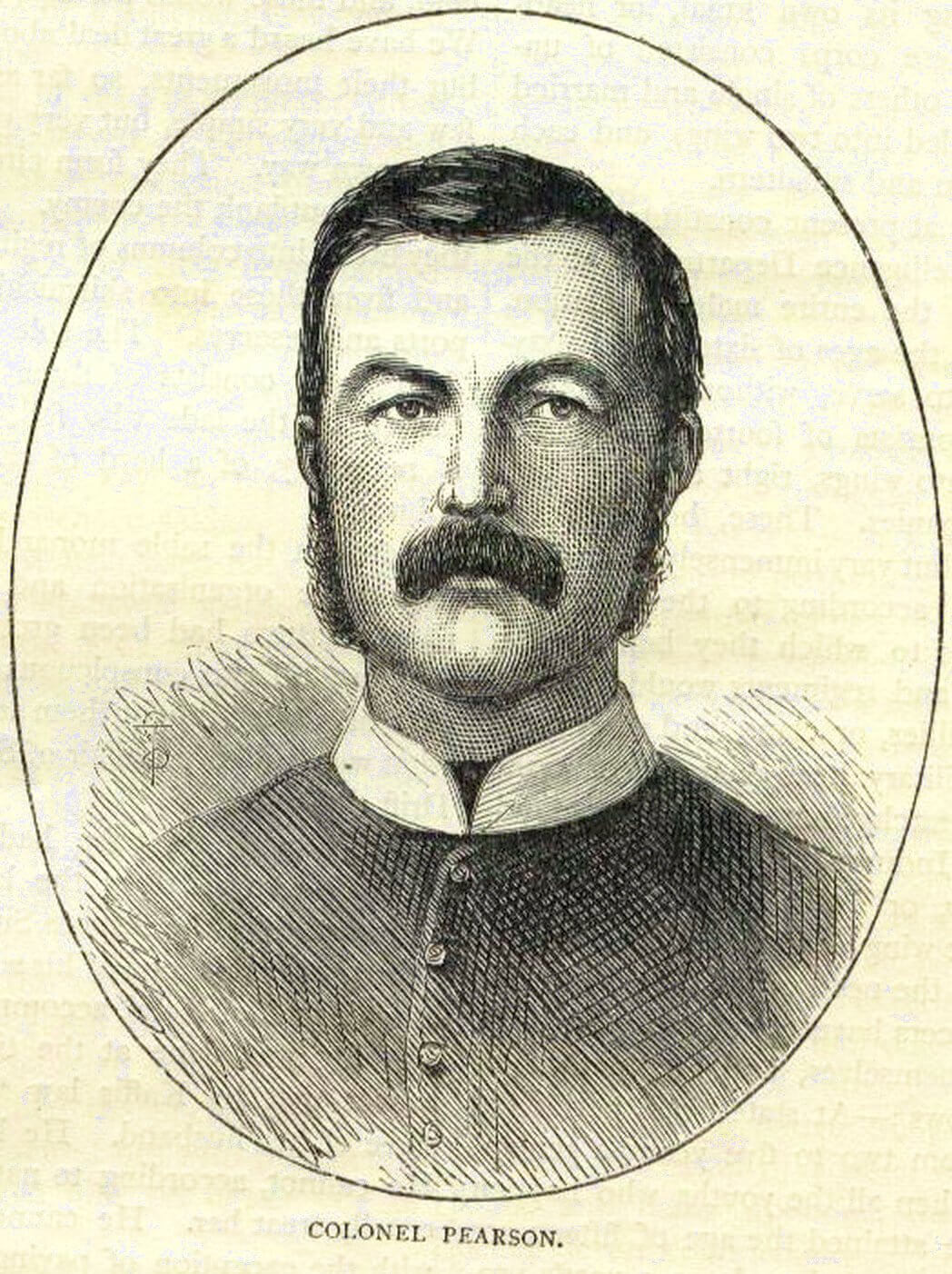
Colonel Charles Knight Pearson, Commander of Chelmsford’s Left Flank Column, Zulu war
The force of 2,500 white troops and 1,700 Africans, to which W J Newmarch was attached took three days to cross the Tugela River into Zululand , virtually unopposed except for a few disappointing skirmishes (The only loss was a trooper who fell into the water and was eaten by a crocodile, the first casualty of the war.) It took a week to build a fort to guard the crossing (Fort Tenedos) and by 18th January they were ready to march north.
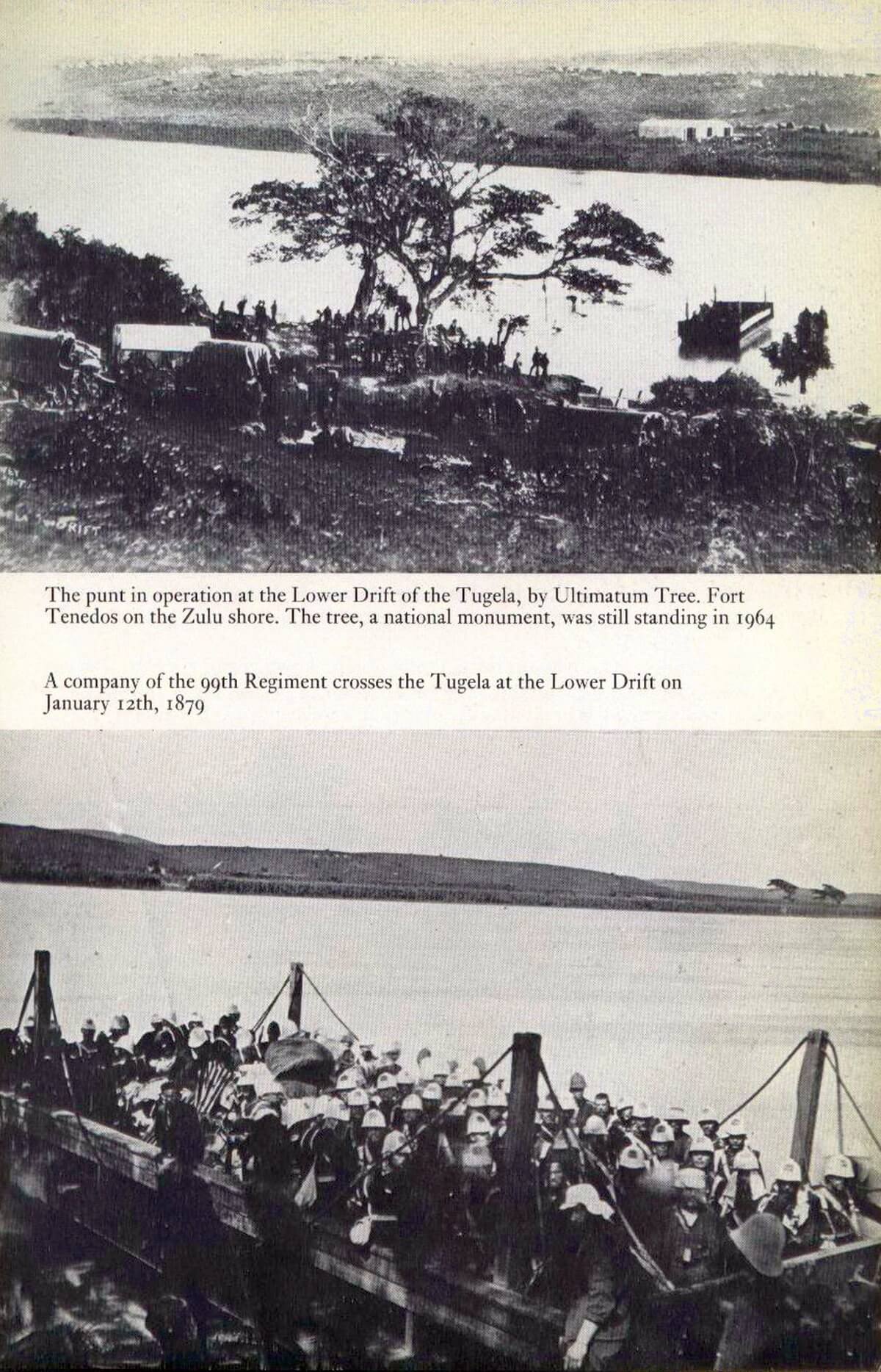
Photos of the Crossing of the Tugela at the Lower Drift (from Donald R Morris’s ‘The Washing of the Spears’)
Their Column’s first major action took place on Jan 22nd not far from King Shaka’s ruined military kraal, Gingindhlovu (“He Who Swallowed The Elephant” – the troops called it “Gin-gin-I-love you”). At the Nyezane River they stumbled upon and surprised five Zulu regiments – the inGulube, the iQwa, the umXapho, the isinGegwe and the inTsukamngeni, over 6000 men on Majia’s Hill who had intended to surprise the column at the Drift. In the event their trap was sprung prematurely, and artillery and rifle fire broke the Zulu left horn before the full attack developed, and the loins (the centre of the Zulu charge) were smashed by gunfire. It was all over in less than two hours with only light casualties on the British side (12 dead against 350 to 400 Zulus).
The column was therefore confident as they reached the old mission station at Eshowe which Col Pearson wished to turn into a strong base from which to launch the right pincer attack on the Zulu capital, Ulundi.
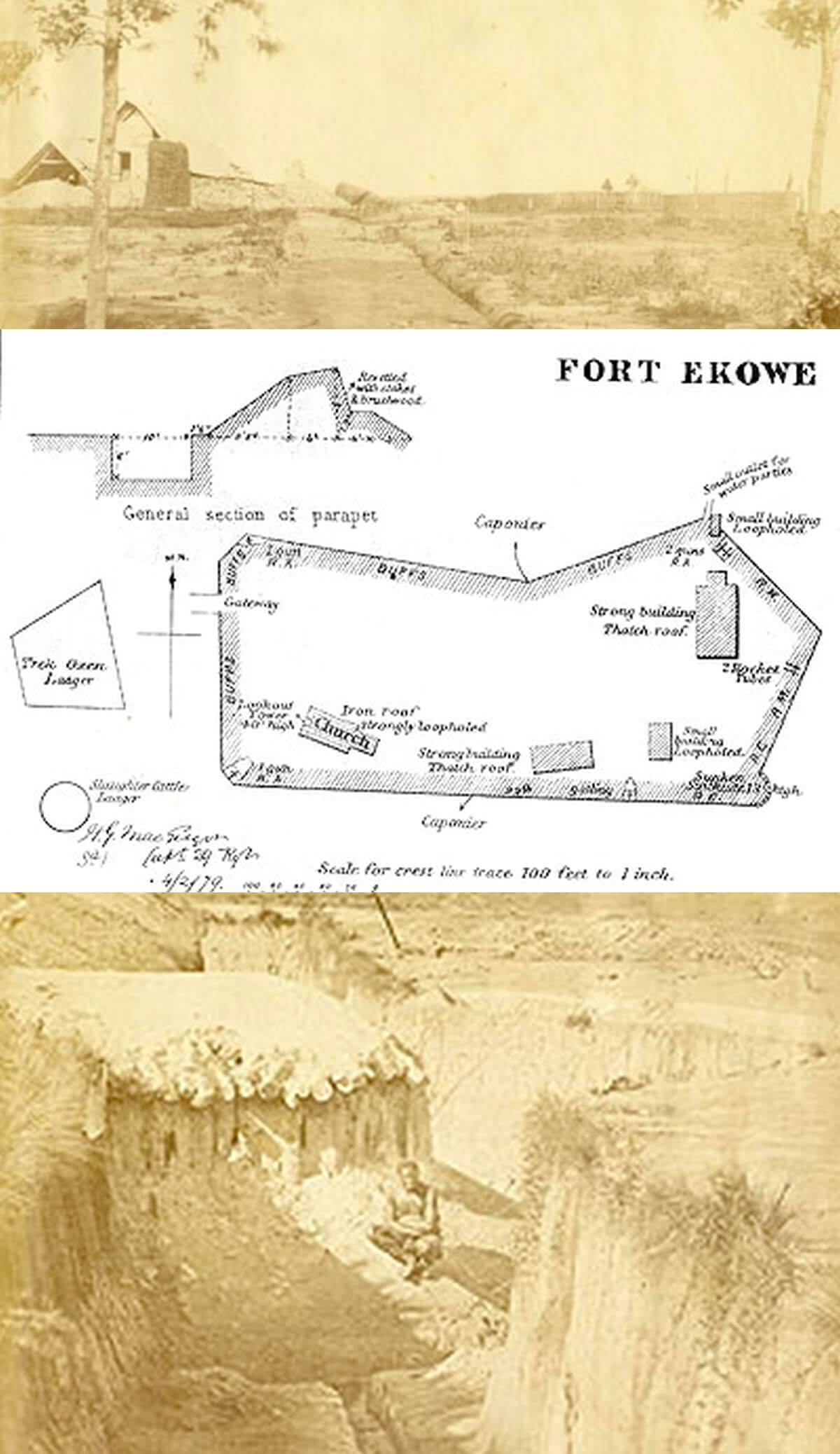
Drawings and map of Fort Eshowe 1879
By the 26th January work had progressed to a point where the outline was visible of an angular oblong fort , 200 yards long and 50 wide, with walls 6 feet high and moat 7 feet deep and 20 across. It was then that runners from Helpmakaar brought an enigmatic instruction from Lord Chelmsford that Pearson had freedom to withdraw back to the Tugela if he felt he could not hold Eshowe. They realised some disaster had occurred but they did not know what. It was not until seven days afterwards, that they learned the full extent of the catastrophe that had befallen the Central Column.. By then the country around was swarming with Zulus, the Right Flank Column’s cattle had been captured and
Pearson realised he was in danger of being surrounded. He evacuated the Volunteers and what mobile troops he had, and with the Imperial troops, waited for the siege to begin. In the event it was not until 2nd April that Lord Chelmsford was able to fight his way to Eshowe and relieve them. Many of the troops perished of malnutrition and disease, including Captain Wynne of the Royal Engineers, who had
designed and built the fort that protected them. W.J. Newmarch was lucky to have been one of the ones evacuated. - At Isandhlwana on 23rd January. Lord Chelmsford and Colonel Glyn had separated their forces leaving Colonel Pulleine in charge of the camp which was attacked by the whole Zulu army. Out of the 1,800 men in the camp only 55 Europeans and 300 Natal Kaffirs escaped massacre. It was the worst defeat for the British Army since the First Afghanistan War, but at heavy cost to the Zulus who lost 3,500 men. It was effectively the end of the first invasion and the British were not to return until the summer. Meanwhile there was terror in Natal which seemed open to Zulu counter invasion.
- The Buffs was the affectionate name for Col Pearson’s own East Kent Regiment He had command here of the 2nd Battalion of the 3rd Buffs
- The single-battalion 99th regiment – the Duke of Edinburgh’s Lanarkshire, commanded by Lieutenant Colonel William Welman
- 240 sailors from the Naval Brigade from the warships Shah and Active, in charge of the rockets and a Gatling gun (under the proud command of Midshipman Lewis Cadwallader Coker.
- A company of the Royal Engineers under Captain Warren Richard Colvin Wynne
- Gatling guns had shown their effectiveness during the US Civil War. The Gatling went into action with the British army for the first time at the battle of Nyezane, described in this letter
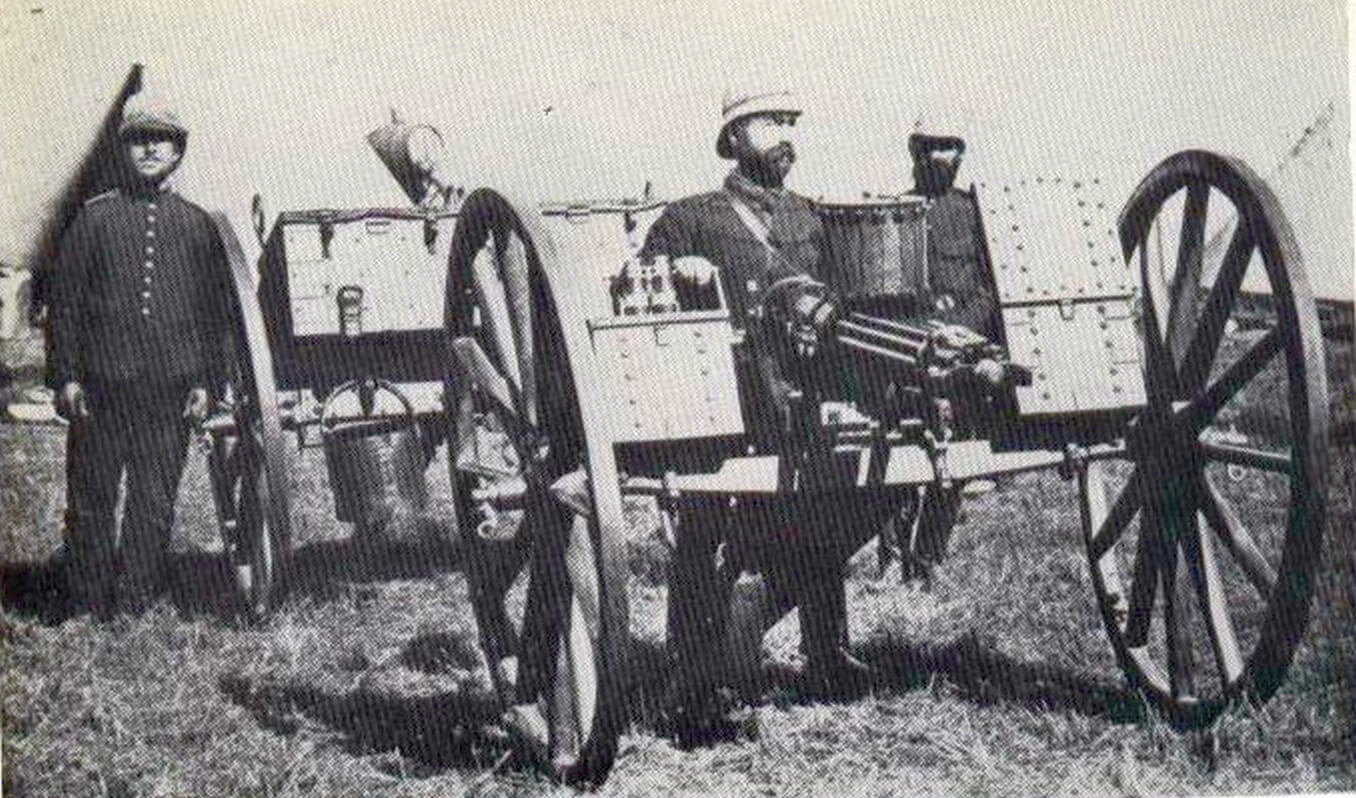
Gatling gun as used in the Zulu War (Photo from ‘The Washing of the Spears’)
- Saul David in his history of the war writes that the defenders only had food for three weeks. In the event the provisions had to last for nearly four months
- This was the Battle of Nyezane. Following is extract from Donald R Morris’s The Washing of the Spears:
“The morning of the 22nd dawned hot and clear, and the column marched at five, starting out through low, swampy ground covered with uinharvested mealies. A mounted patrol scouted the way and Wynn’s engineers and the Natal Native Pioneers preceded the infantry to repair the road for the wagons behind. The next stream was the Inyezane….The track rose sharply beyond through tumbled hills and a dense forest to the edge of the plateau on which Eshowe was located, and there would be hard work for man and beast on the next march.
Directly ahead lay a steep E-shaped ridge, Majia’s Hill, and the track ran up the centre spur, separated from the flanking spurs by deep, swampy ravines choked with dense growth. The crest of the ridge was open, and halfway up the centre spur, just to the right of the track, was a large, bare knoll. By 8.00 o’clock the troops were all resting over their breakfasts, and the first of the wagons was coming across the drift to outspan on the north bank. A few Zulu scouts appeared near the knoll on the centre spur, and Pearson ordered Lieutenant Hart to take his company of the NNC [Natal Native Contingent] up the track to drive them away. Hart called his men together and started out, but before he could reach the knoll, the Zulus dropped off the centre spur, crossed the ravine, and reappeared on the right spur a quarter of a mile away.
Nothing loath, Hart left the track and started his men across the ravine in pursuit. He had considerable difficulty in herding them along; the men were reluctant to advance and lost all formation in the tangled growth, none of the officers in his company spoke Zulu and most of his N.C.O.’s were foreign labourers who spoke no English. Breathing heavily, the company finally scrambled out of the ravine and started to reform on the right spur. Almost immediately a dense mass of Zulus appeared on the crest of the ridge ahead, opened a heavy fire on Hart’s men and started to pour down the spur, obviously headed for the Inyezane, where they could outflank the bivouac and cut into the line of wagons behind. Hart’s natives possessed exactly ten firearms, only five of them Martini-Henrys, and they needed no urging in any language to decide on the next move. They plunged back into the ravine, scrambling for safety of the centre spur and the bivouac, while the European officers and a few of the N.C.O’s made a stand to return the fire. Before they were all swept off the spur, Lieutenants Raines and Platterer and six of the men were dead, and Lieutenant Webb and another man were wounded.
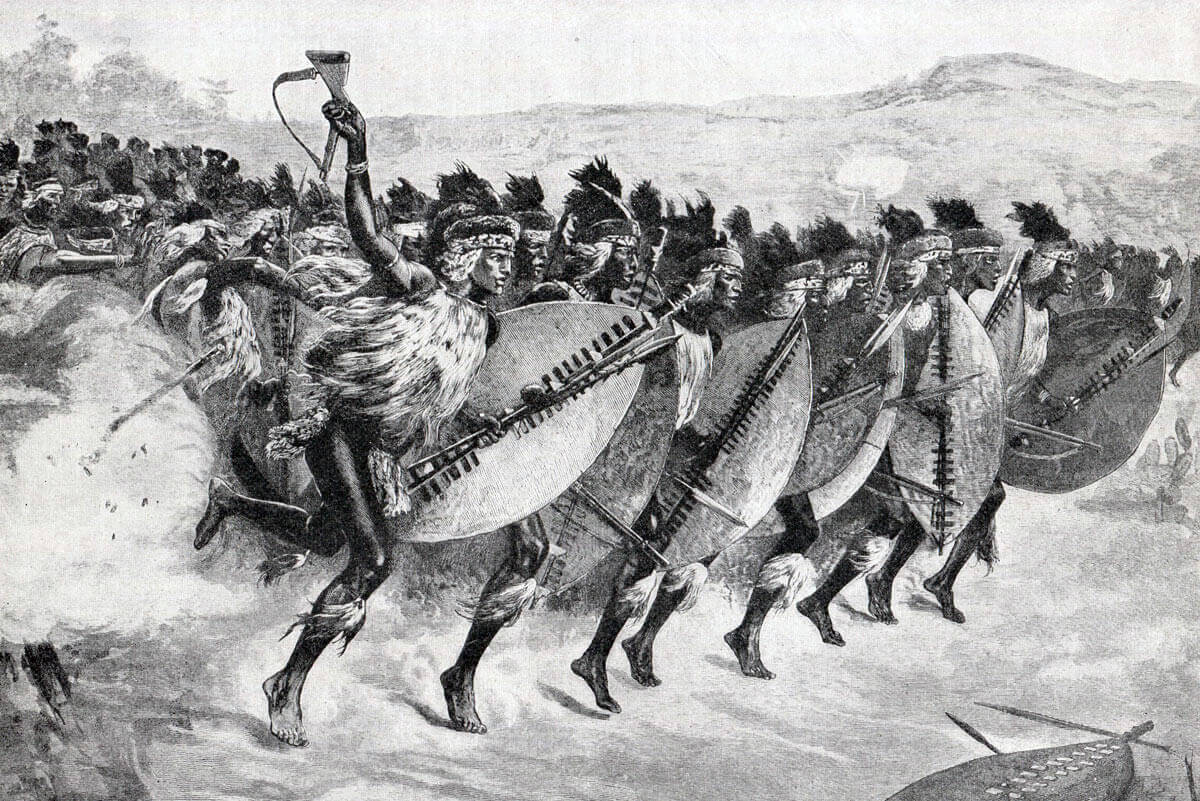
Pearson started the nearest troops up the track on the centre spur the instant he heard the firing. Lieutenant Lloyd’s two guns had just crossed the drift and he reached the knoll hard on Pearson’s heels, unlimbering and coming into action even before either Commander Campbell and a hundred men of the Naval Brigade or the two leading companies of Buffs arrived. The infantry spread out on the knoll and settled down to fire at the Zulus, now strung out along the entire right spur.
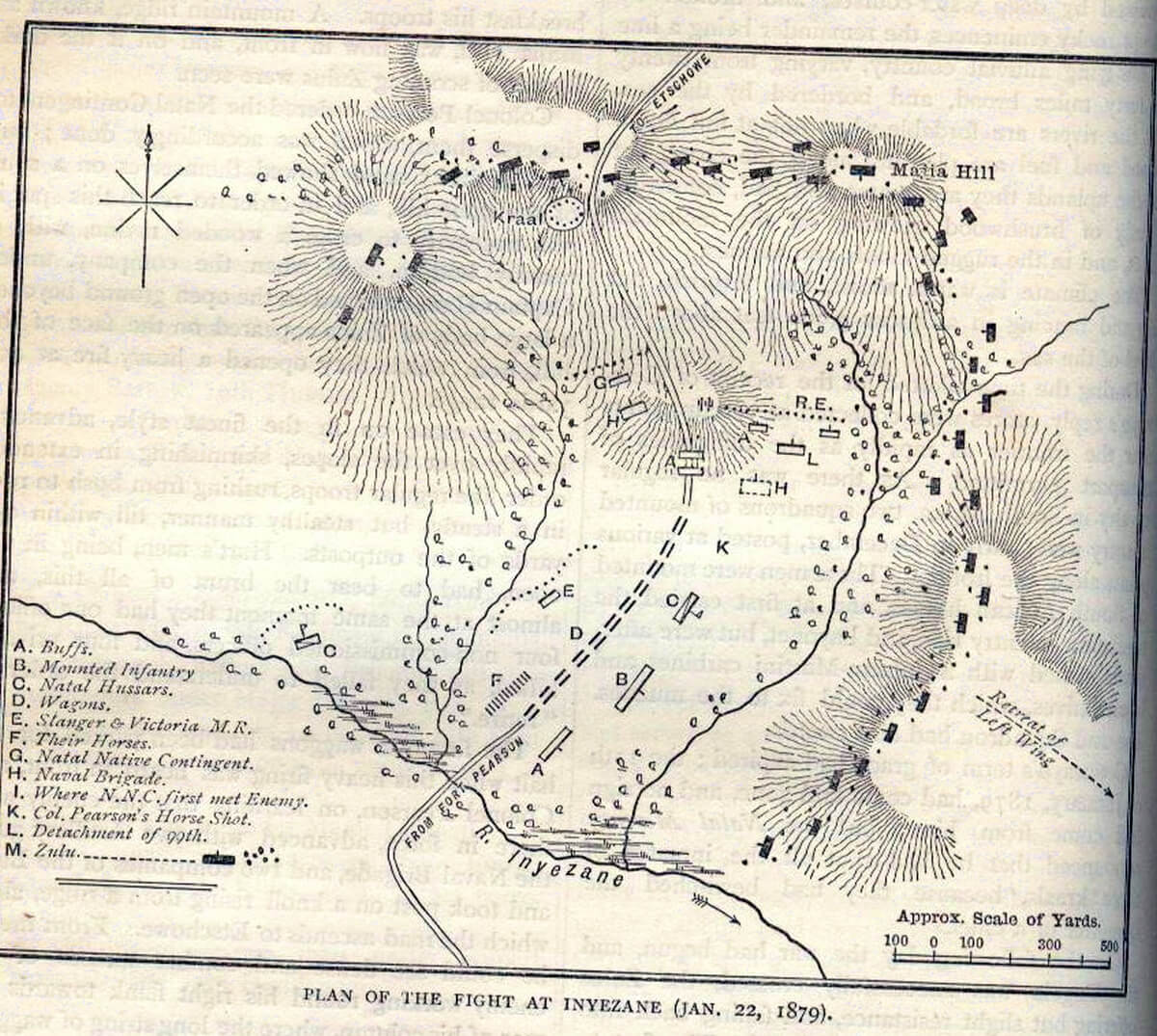
Map of Battle: W J Newmarch is positioned with Natal Hussars at ‘C’
The leading warriors had already reached the foot of the spur and turned to their right, disappearing in the thick bush… and closing the wagons. Barrow’s cavalry dismounted at the foot of the centre spur and turned right to fire on the drift; they dropped their shovels, grabbed their rifles, and doubled through the bivouac to join Barrow. Two more companies of the Buffs, set to guard the wagons, joined him as well, while Coke’s sweating sailors manhandled their unwieldy Gatling gun up the track toward the knoll. For ten minutes or so the entire centre spur from foot to knoll was wreathed in smoke, twinkling with the red spurts of the fire, and the ear-splitting din of 600 rifles was punctuated by the deep roar of the artillery. Pearson’s horse was shot and collapsed, but the Zulu fire was light. The black trickle down the right spur slowed, stopped, and then the Zulus started back. Barrow opened the men on the flat into skirmishing order and started through the bush to drive the remnants out. There was a small kraal to the left of the track on the centre spur, high above the knoll near the crest of the ridge, and while the Zulus on the right were under fire, a second mass of warriors had taken possession of it, and still more were moving along the crest behind it to the head of the spur on the left. Commander Campbell now started up the track for the kraal, stoutly supported by Hart’s European survivors. The artillery left off hammering the right spur and directed its attention to the kraal, setting it afire. The sailors reached the kraal and occupied it with still another company of the Buffs, and Coker brought his gun up and opened fire as the Zulus abandoned the crest and melted into the countryside beyond. The skirmishers coming up over the right spur drove the survivors of the original attack over the crest to join the rest of the retreating impi, and the firing died down.
It was all over in an hour and a half. Two of the Buffs had been killed on the knoll; five more, seven sailors and two of Barrow’s mounted men had been wounded. With Hart’s original casualties, the total loss was ten men killed and sixteen wounded. The Zulus carried off their own dead, and only one Zulu, wounded in the leg, could be found….
….Pearson reached Eshowe the following morning…..
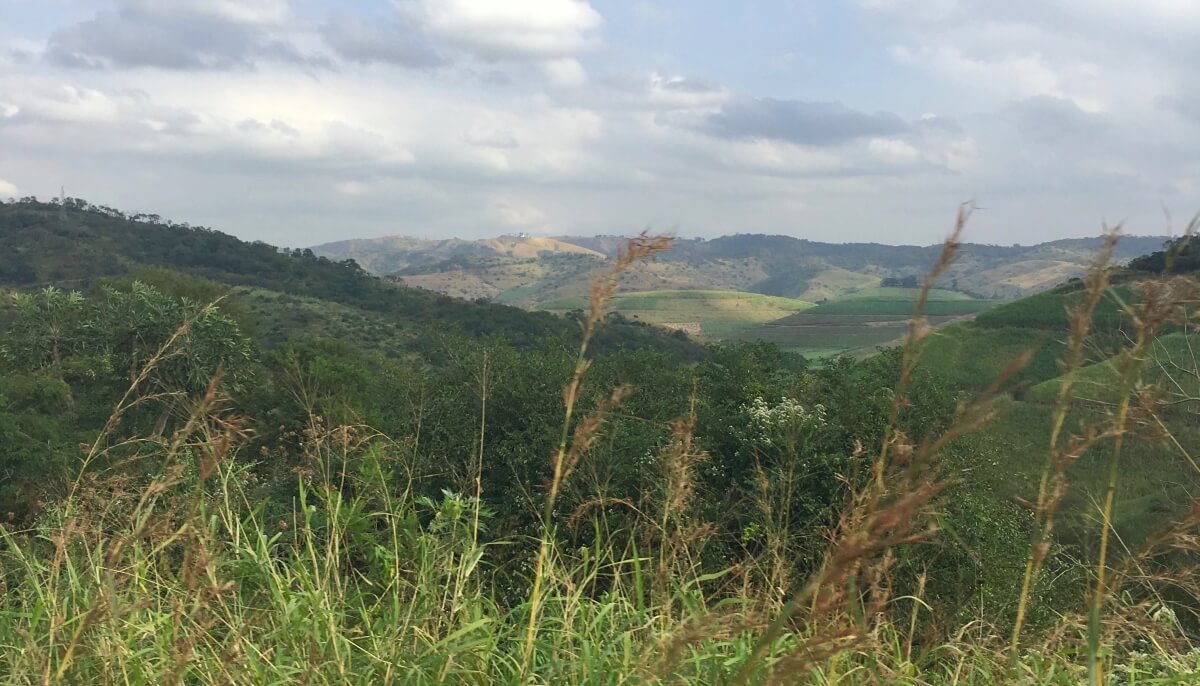
Inyezane
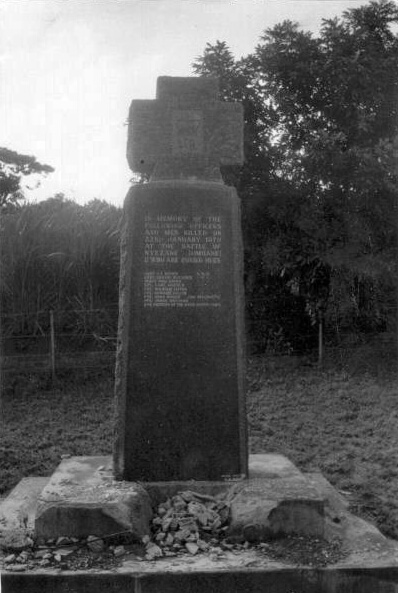
Memorial to the white officers and soldiers slain at Nyezane
- There is an ominous note here, Kranz Kop is the town just south of the Middle Drift of the Tugela which under Chelmsford’s plan had been little defended, although many feared that it would be over this drift that the main thrust of any Zulu invasion of Natal would take place. W JS Newmarch is hinting to his parents that the worst may not have happened yet and if it did he would be in the thick of it. In the event Cetshwayo had given orders to his armies that there should be no attacks into Natal.(The attack on the mission station at Rorkes Drift on the night of 23rd January had been in disobedience to the king’s orders.
- William John Newmarch, eldest son of George William Newmarch and Christina Duff Doig, grandfather of Mike Newmarch and great grandfather of Peter, born 11th March 1861. He was still 18 years old when he went to war.
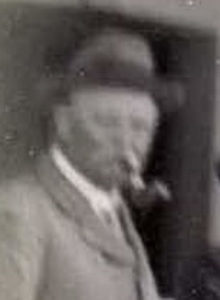
W J S Newmarch in later life
- Presumably this is still the W J S Newmarch whose earlier letters describe him marching with the Right Flank Column in the early days of the war, fighting a battle at Inyezane and then returning to Natal before the siege of Eshowe closed in. He was then riding with the Natal Hussars, a Mounted Infantry unit from Greytown, but if he is in Zululand now it must be in another capacity, because after Isandhlwana, the Governor of Natal, Sir Henry Bulwer, who opposed the war and who was feuding with the military commander, Lord Chelmsford, gave an order that no Natal Mounted Rifle Units would in future be allowed into Zululand. They were required for the protection of Natal. Several firebrands opposed this, resigning from their Mounted Rifle Units in the determination to get back into the war in another way. They set up a new unit called the Natal Volunteer Guides, with Captain Friend Addison, erstwhile of the Stanger Mounted Rifles elected as their commander. They duly offered their services to the Imperial Cavalry Officer, Major Percy Barrow of the 19th Hussars, who had commanded the Natal Mounted Units at the Battle of Inyezane, and he involved them in his operations for the rest of the war, using them primarily as scouts and irregulars.
Some of the volunteers were very young (famous was 16-year-old John Robinson Royston of the Isipongo Mounted Rifles, who would not accept refusal and swam his horse across the Tugela to join them) and it is surely not impossible that 18-year-old W J S Newmarch also volunteered.
Peter Newmarch has a reproduction of a map from the Newmarch Collection in the Killie Campbell Museum in Durban showing (apparently) engagements which W J S Newmarch was involved in during the Zulu War:
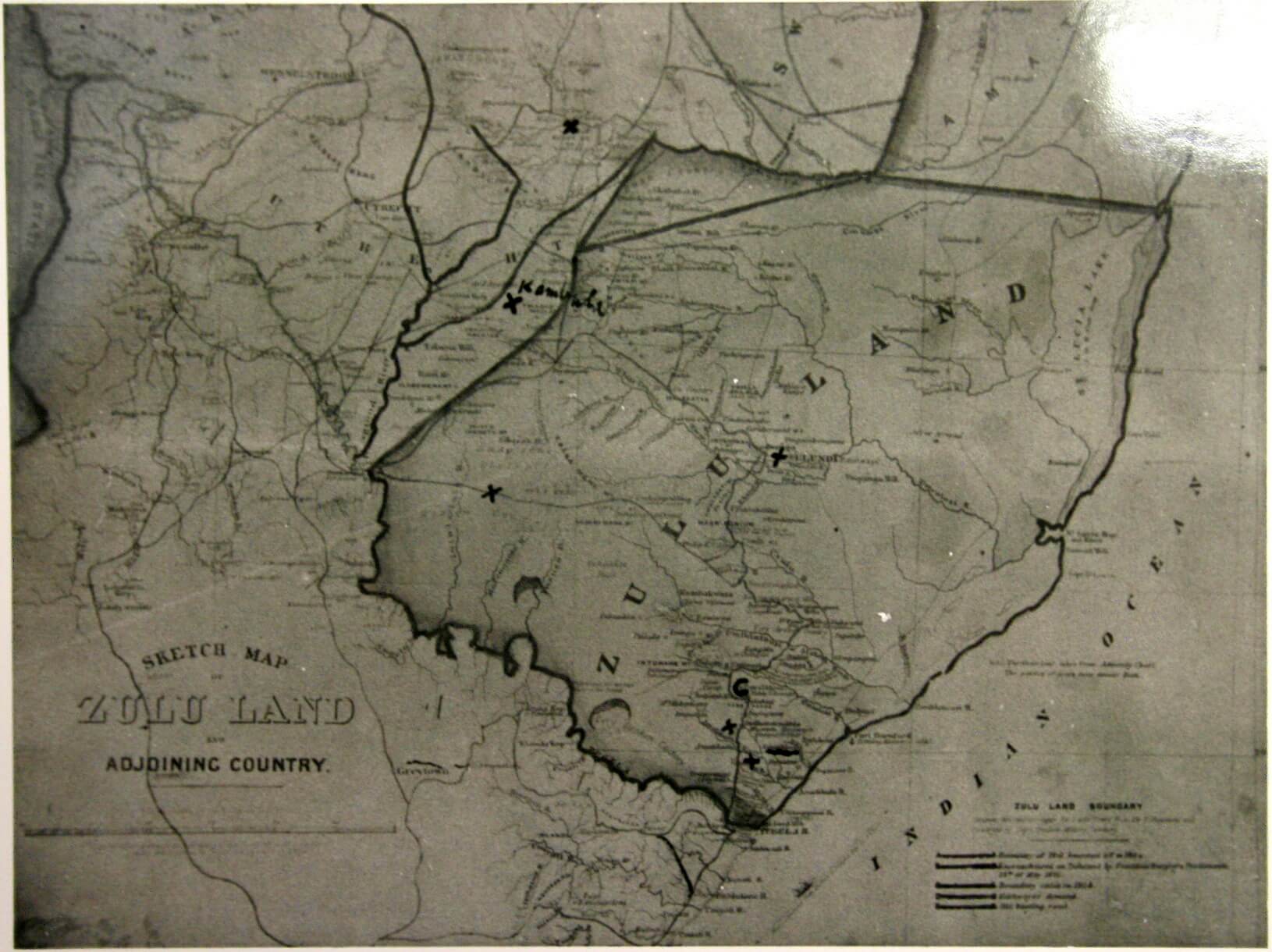
Zulu war map in the Newmarch Collection of the Killie Campbell Museum, Durban
It is very wide ranging. Inyezane is there marked with a cross, and also close by another cross. I thought at first this might be the Battle of Gingindhlovu fought on 2nd April 1879 when Chelmsford relieved Eshowe and suggested that, in some capacity, W J S Newmarch was in the Relief Column – but then how could he four days earlier be at the Battle of Kambula, Col Evelyn Wood’s victory on March 29th that turned the tide? I suspect that the cross is therefore not Gingindhlovu and may be the minor skirmish he was engaged in the day he crossed the Tugela with Col Pearson in the January campaign. Kambula is so clearly marked – with the word written in long hand next to it that it – if this really is a record of his engagements – suggests he was there. There are two other crosses, one on the border with Transvaal, another in south west Zululand which are not easily identifiable, and there is a cross at Ulundi which suggests he was present during the final battle of the war. But then how could he have managed to have such an active war after the Natal Hussars were banned from taking part?
It only makes sense if had joined a scouting unit like the Natal Volunteer Guides. (There were in fact several of these irregular guide contingents – J W S Newmarch may not have joined the Natal Volunteer Guides initially – indeed there is no mention of a Natal Hussar man in the first intake of 62 guides, but four Natal Hussars joined a similar unit formed by Captain Theophilus ‘Offy’ Shepstone, who participated in a major raid across the Tugela north of the Middle Drift on 20 May – which actually ties in with the cross in southwest Zululand on Peter’s map – it was a preparatory raid before the main army advanced a week later in an invasion attempt that was to end tragically in the death of Prince Louis Napoleon. It is possible that W J Newmarch attached himself to Shepstone and/or another initially, and this might have taken him to Kambula and the other western battles, and maybe he joined the Natal Volunteer Guides when the second invasion of Zululand began, fighting his way to Ulundi – source: Zulu War – Volunteers, Irregulars & Auxiliaries (Men-at-Arms) )
(As Peter Newmarch points out: “Newmarch would have been fluent in Zulu along with the other volunteers – and I think the British would have quickly adapted to this by placing them in intelligence gathering, overseeing the natives etc.[The settlers] were all excellent shots, could live in the bush without problems, knew their way around Natal and perhaps more importantly also as trackers – they had a way of being able to see signs in the bush from hunting animals.”)
This is all speculation, but this letter would fit perfectly into the scenario described, because the Newmarch being addressed is quite clearly up-country in Zululand, on his own on some independent patrol involving the recruitment of Natives, an interpretation actually endorsed by the Killie Campbell Museum map which in addition to crosses of battles also has sections of countryside in the coastal areas of Zululand inked in which were on the march of the army north and which he might have reconnoitred.
The date and address of this letter firmly places the events being described as taking place in what is called the Second Invasion of Zululand, which Chelmsford launched in May. There were to be two columns this time, the western one (2nd Division) commanded by Col. Evelyn Wood, victor of Kambula, to which Lord Chelmsford attached himself; the eastern (1st Division) was commanded by Major General Henry Hope Crealock. The plan was for both to converge on the Royal Kraal of Ulundi where it was hoped a decisive battle would take place to end the War.
The route of Crealock’s Division was directly north from Fort Pearson and Fort Tenedos at the Lower Drift of the Tugela, its goal to reach the Umhlatuzi River, 40 miles inland, where it would destroy the Undi and Emangwene military kraals thus securing the East of Zululand before converging with the 2nd Division at Ulundi.
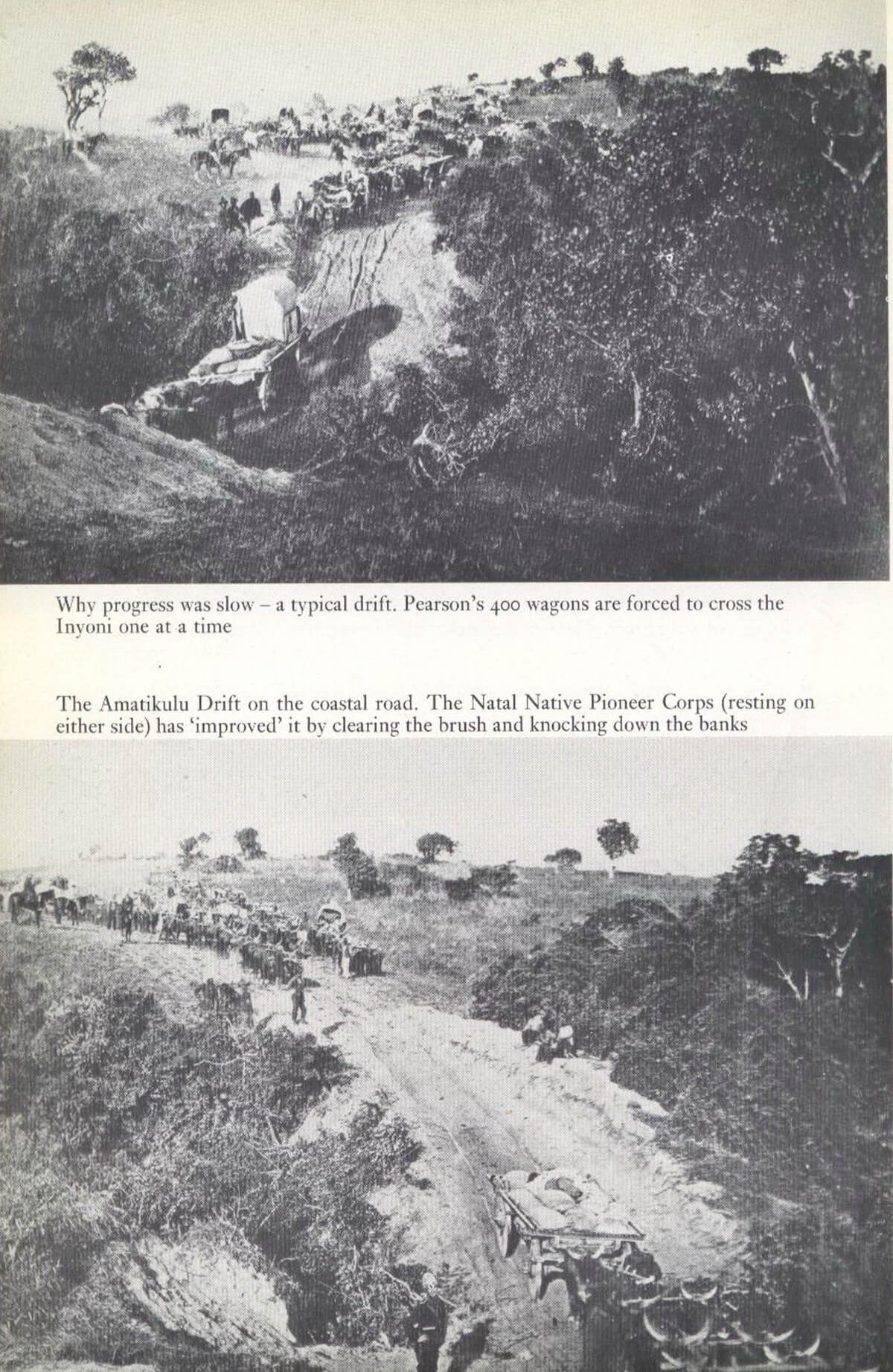
Pearson’s earlier advance along these roads in dry weather – in the perpetual rain accompanying the invasion they were quagmires
The pace of the advance was snail-like. New troops had arrived from England and these were not used to the country so their march up from Durban was devastatingly slow. The advance troops marching north from river to river making forts as they went were bogged down in rain, mud and disease, and General Crealock himself was not a man to inspire confidence. (General Garnet Wolsely, who replaced Chelmsford, later said of him, “He came out to meet us. Just the same vain swaggering snob he has always been. I believe his manner to his Staff & all about him is most disagreeable & his manner to the men…is offensive…as far as this war is concerned, this first Divn. might as well have been marching along the Woking & Aldershot road. If he had been eager for the fray he might have brought the enemy to an engagement near the Inyezane or Emlalazi rivers & so had the credit of finishing the war before Chelsford did so but Crealock is more of the Autumn Manoeuvre General than the fighting leader in the field.” – these sentiments about the conduct of the campaign are certainly echoed in the letter above!)
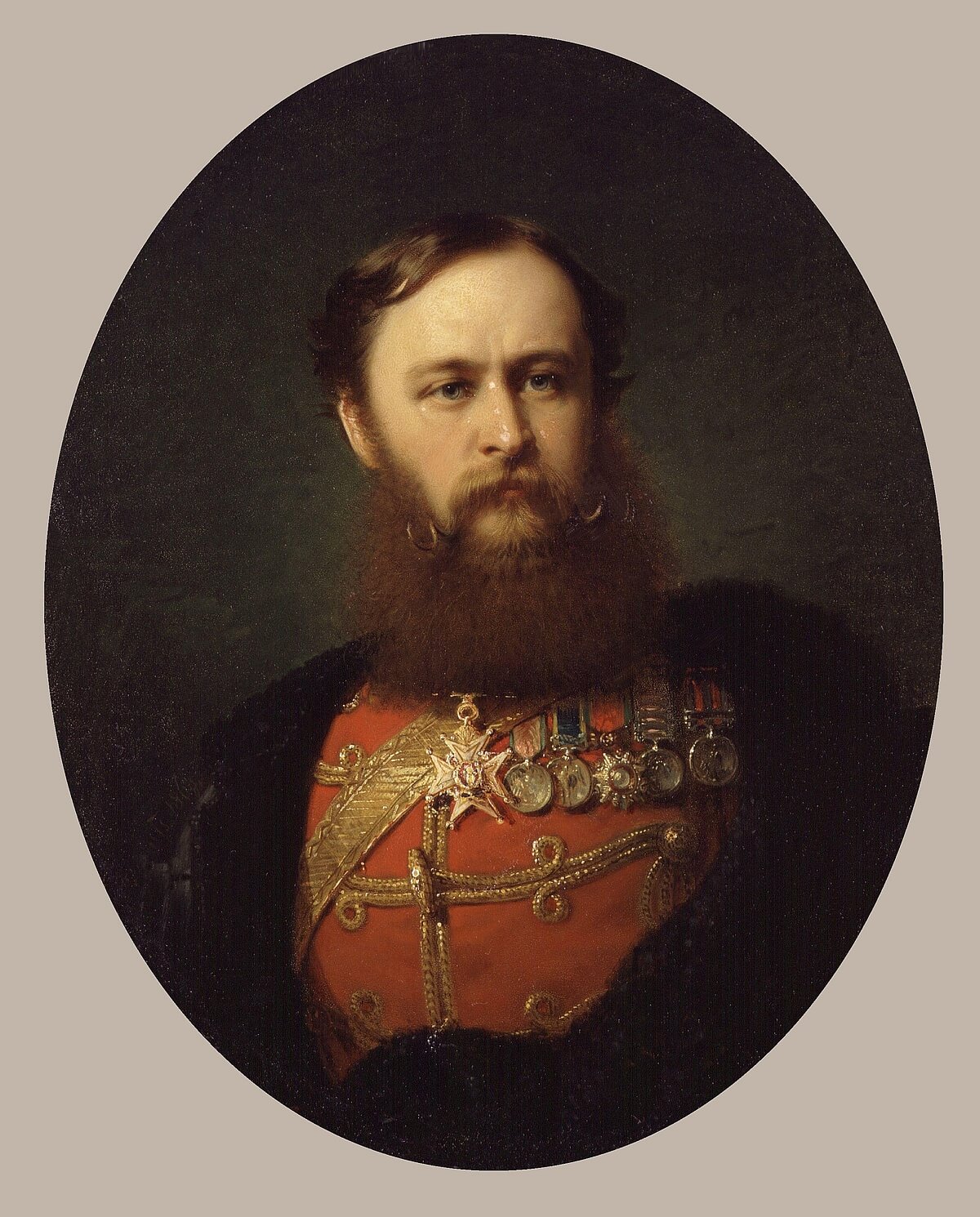
General Henry Hope Crealock
By 16th June the army had advanced over the Inyone, Insundusi, and Amatikuzuu. Rivers (where Crealock built himself a fort (naming it after himself) and had got as far as the Inyezane river close to the battleground of Gingindhlovu where he built Fort Chelmsford – where the author of this letter is sitting in frustration waiting for further movement. Many of the men stationed there had fallen ill and some had succumbed to disease caused by the unsanitary conditions of streams poisoned by bodies from the recent battle of Gingindhlovu, constant rains (which the writer mentions) and the general unhealthiness of the coastal area. A malaise seems to have settled on the expedition which the letter reflects. .The author shows nothing but scorn for the timidity of the British forces in his story about an armed guard being sent to the Umlalazi River for water supplies because they were afraid of being shot at. The author echoes Wolsely’s view that Crealock should have offered battle at the Umlalazi.

In fact in three days of this letter being written, there finally was movement on the eastern front. On 19th June the last troops did all arrive in Fort Chelmsford, the Umlalazi river was crossed with no opposition on the 22nd June and on 4th and 5th July, Major Percy Barrow’s flying column (including W J S Newmarch?) achieved the division’s objective by burning the Emangwene and Undi Kraals.
Eastern Zululand was secured. Fort Napoleon was built to secure the area and to guarantee protection to nearby Port Durnford, and the final stage of the War, the march on Ulundi could begin.`
One can only guess from the contents of the letter what exactly W J S Newmarch was doing. He is clearly further north of Fort Chelmsford (the writer of the letter asks him if it is also raining as badly ‘up there’ – possibly near the Umlalazi River). He is presumably on some sort of mobile patrol and has recently acquired, or more likely recruited, some Natives to act as guides. Fort Chelmsford has sent George Robinson with horses for them. The tone of the letter is very much one between equals, two young independent minded settlers expressing their frustration with the dilatoriness of their military superiors.
- No identification yet of who George Robinson might be.
- Presumably somewhere close to the Umlalazi River north of Fort Chelmsford
- Is the fool referred to here General Crealock?
- It needs a better palaeographer than me to interpret this scrawl. Assume this is Newmarch’s liaison,
perhaps superior officer among the Volunteers in Fort Chelmsford.
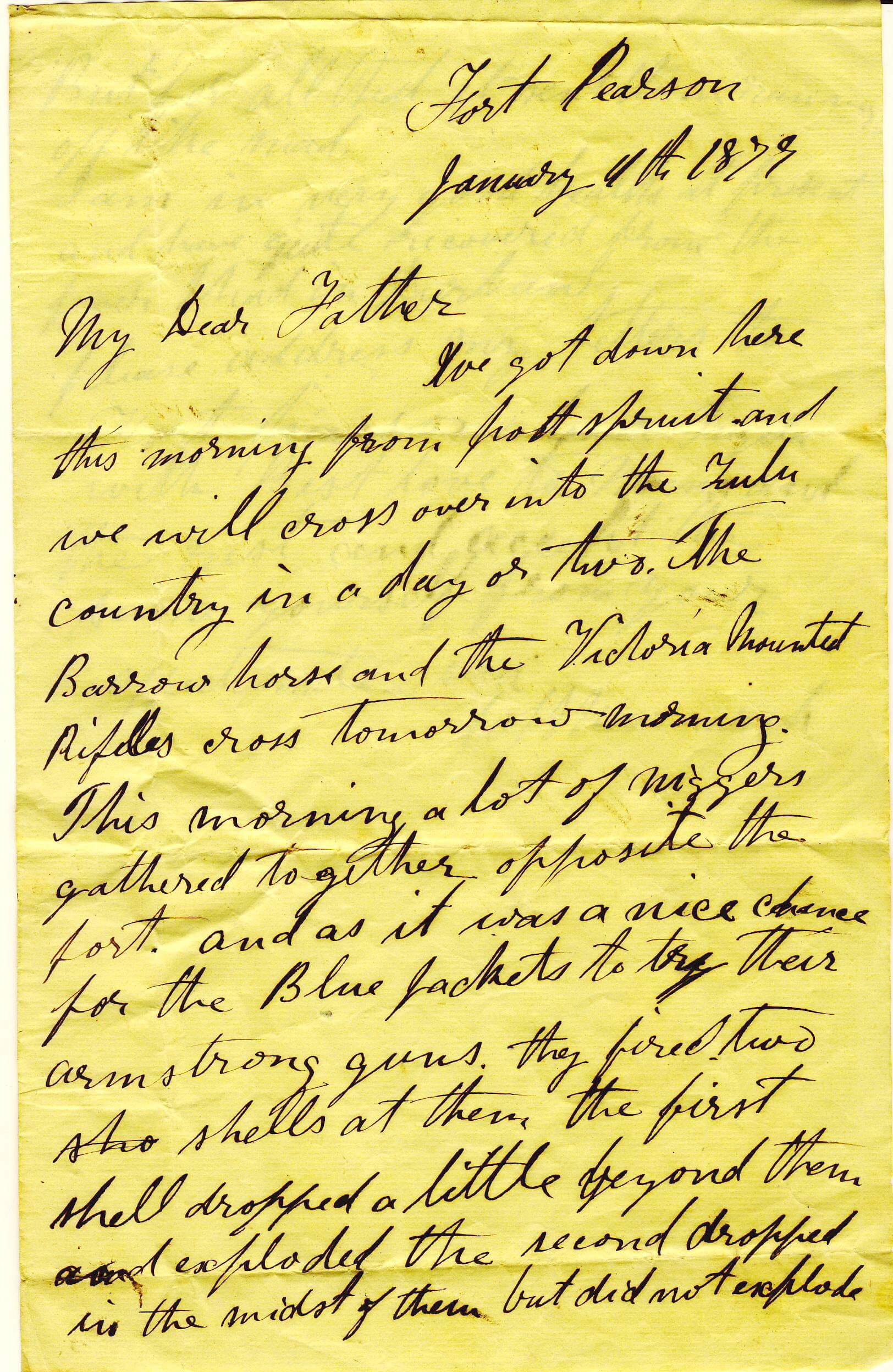
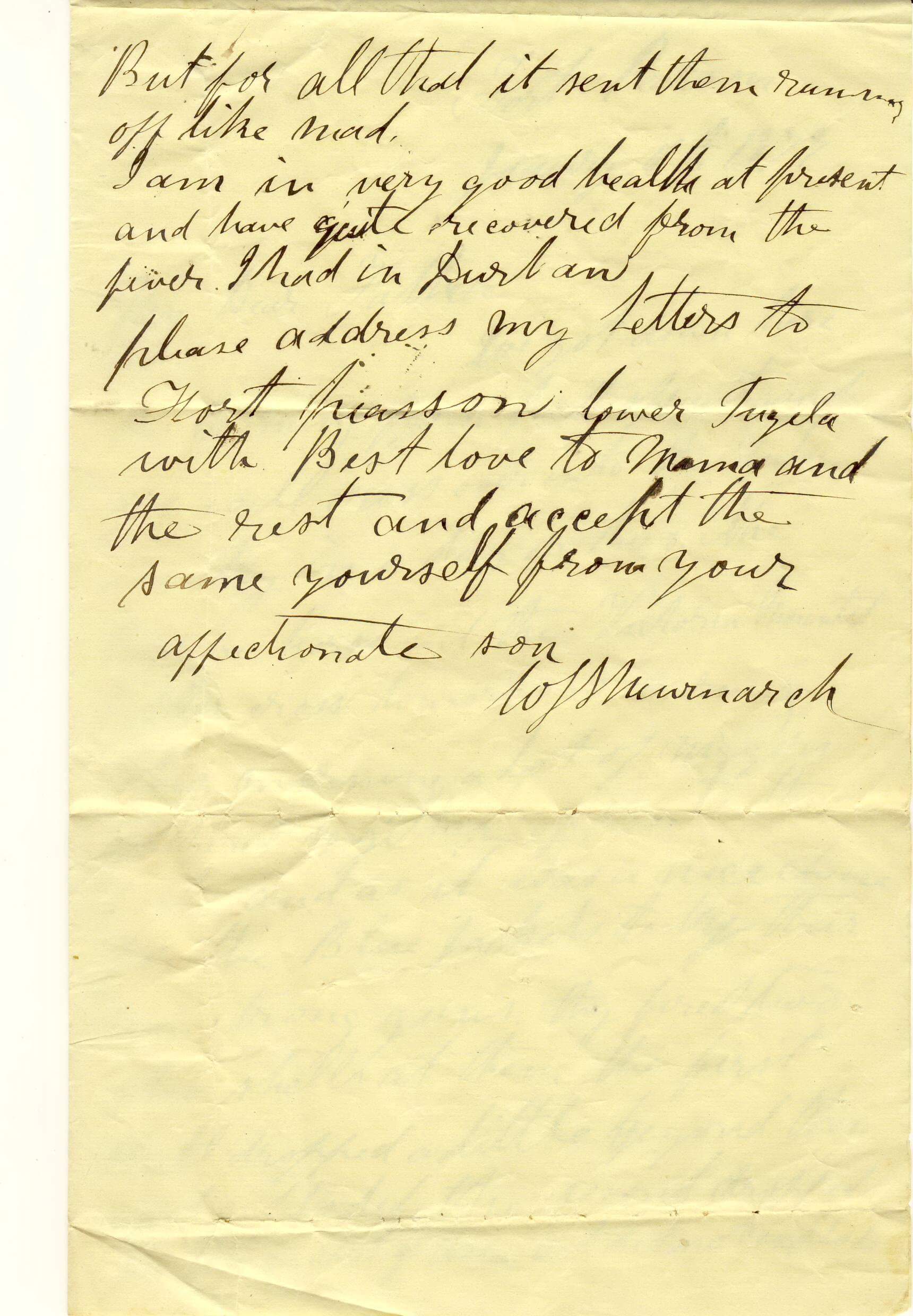
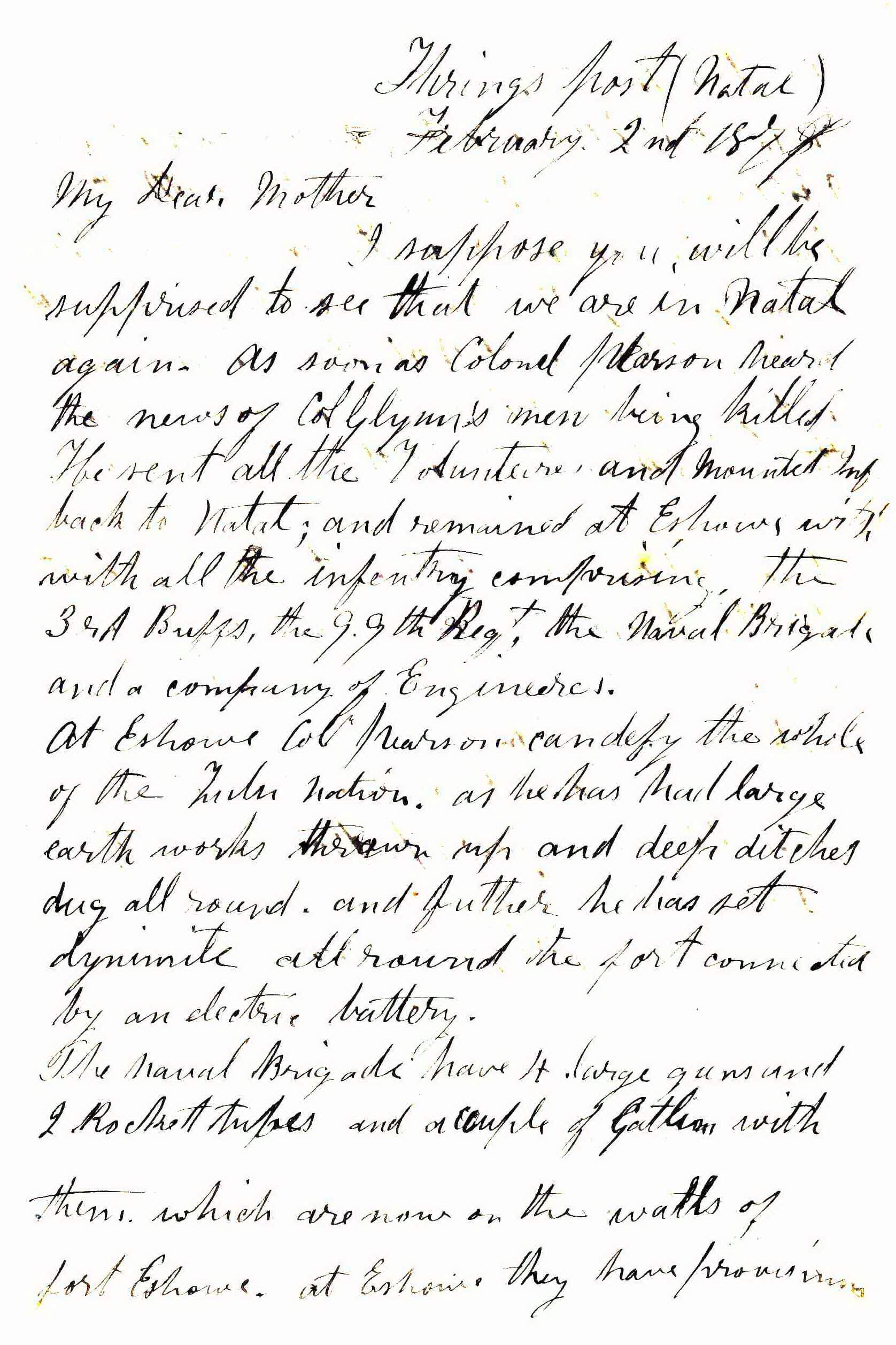
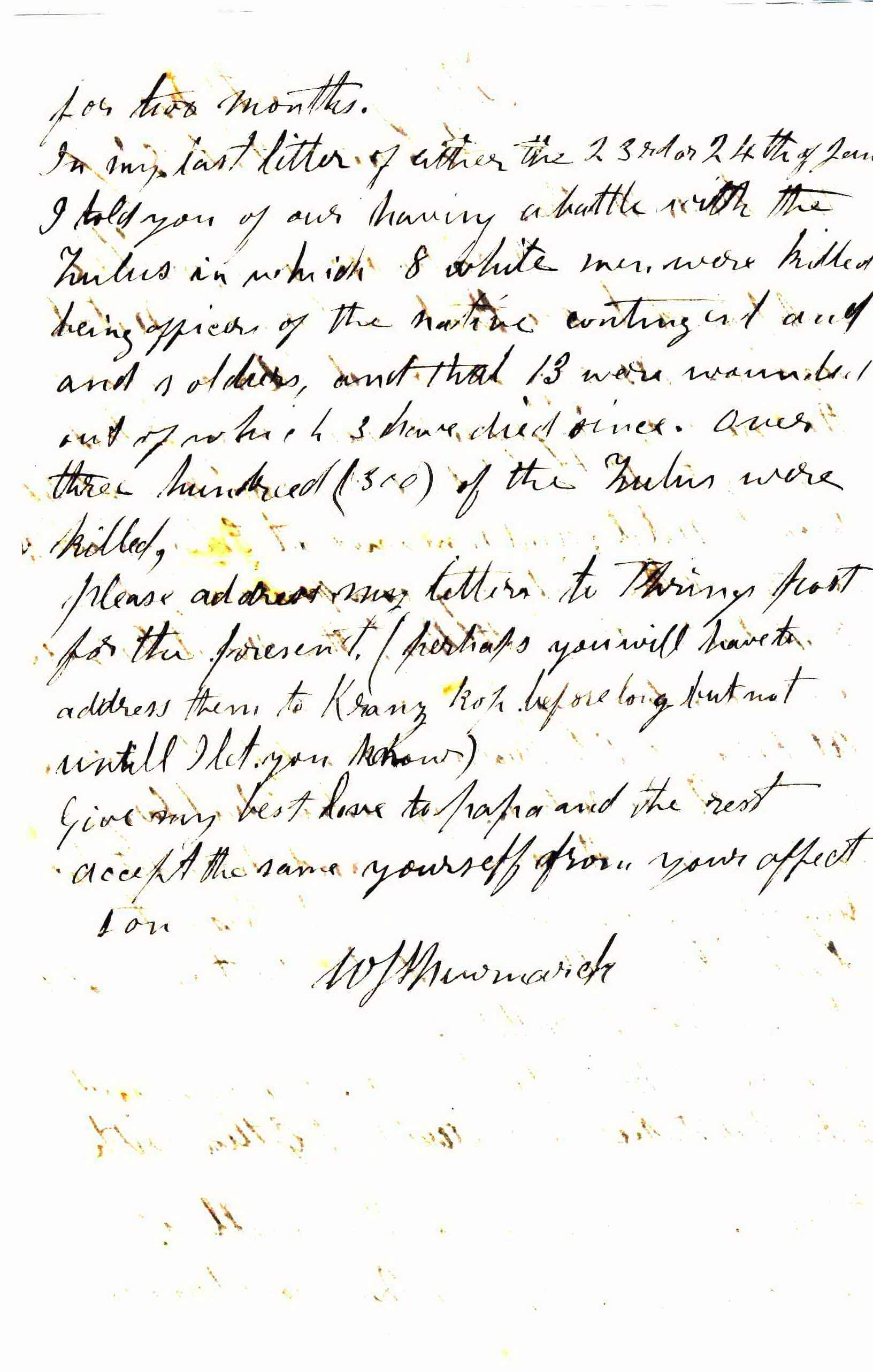
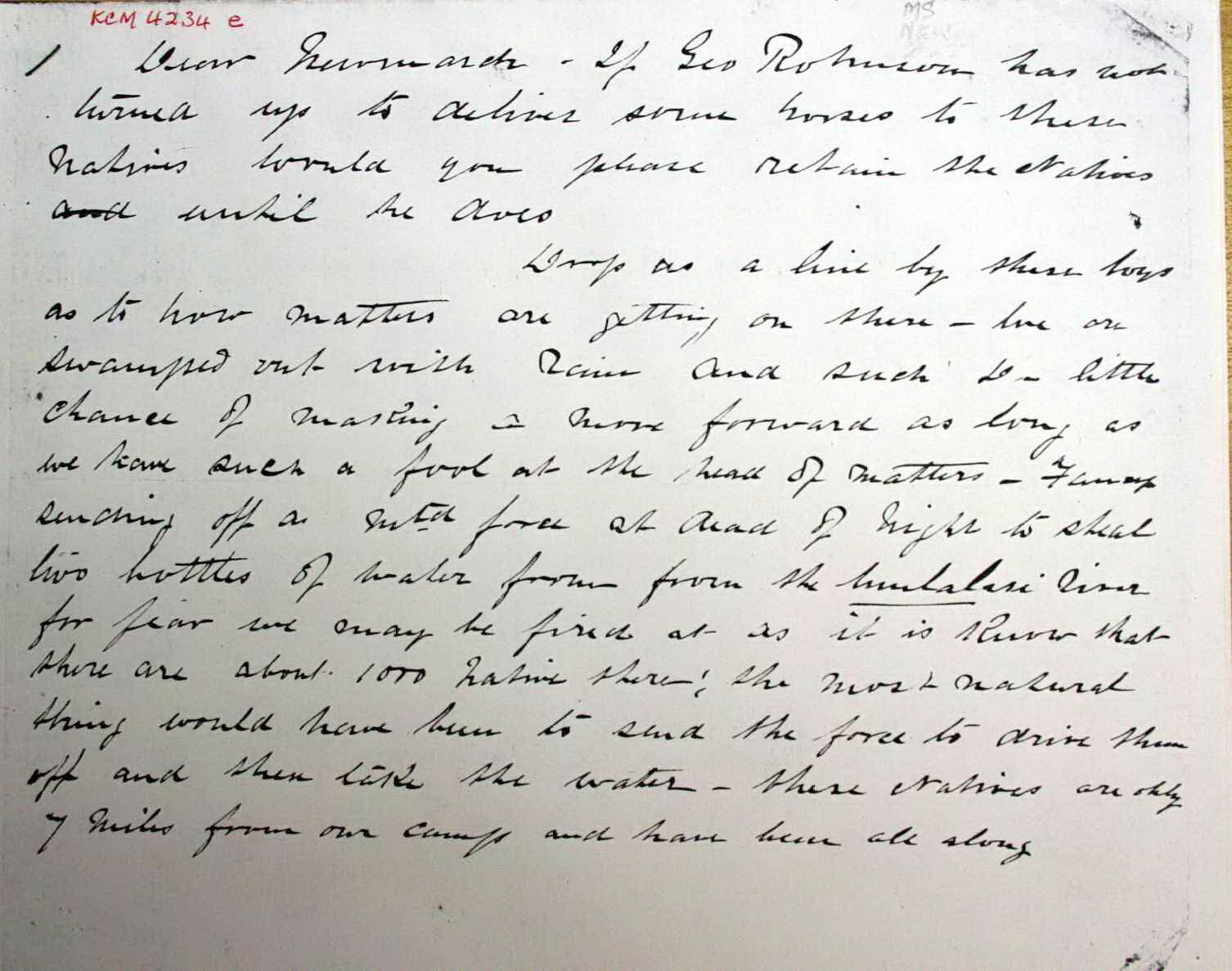
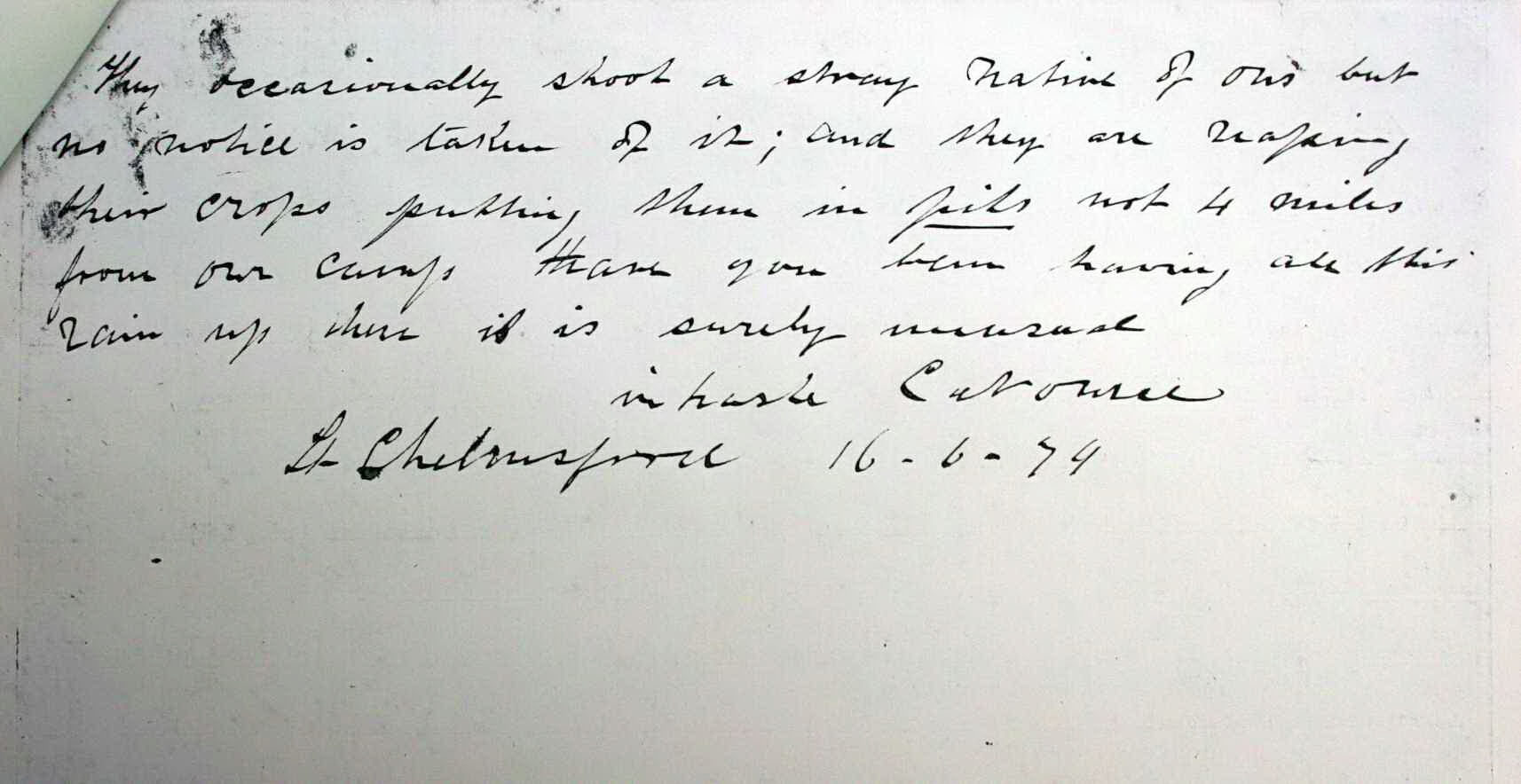


What a amazing account of affairs then . So interesting and historically important .I live in Stanger — and my great granfather had the store at Mtombeni and witnessed all this around him according to his diaries .How can I get a copy of this article and or the printed book ?
Kind regards
Howard Balcomb —alizecottage@gmailcom
Very good information and pics. Thanks for compiling this. I’m planning a trip to this area and appreciate the info.
Some great stuff here, really interesting! You might find something useful in ‘Fearful Hard Times; The Seige and Relief of Eshowe’ by Ian Castle and myself.
Excellent. I have posted a link on my website.